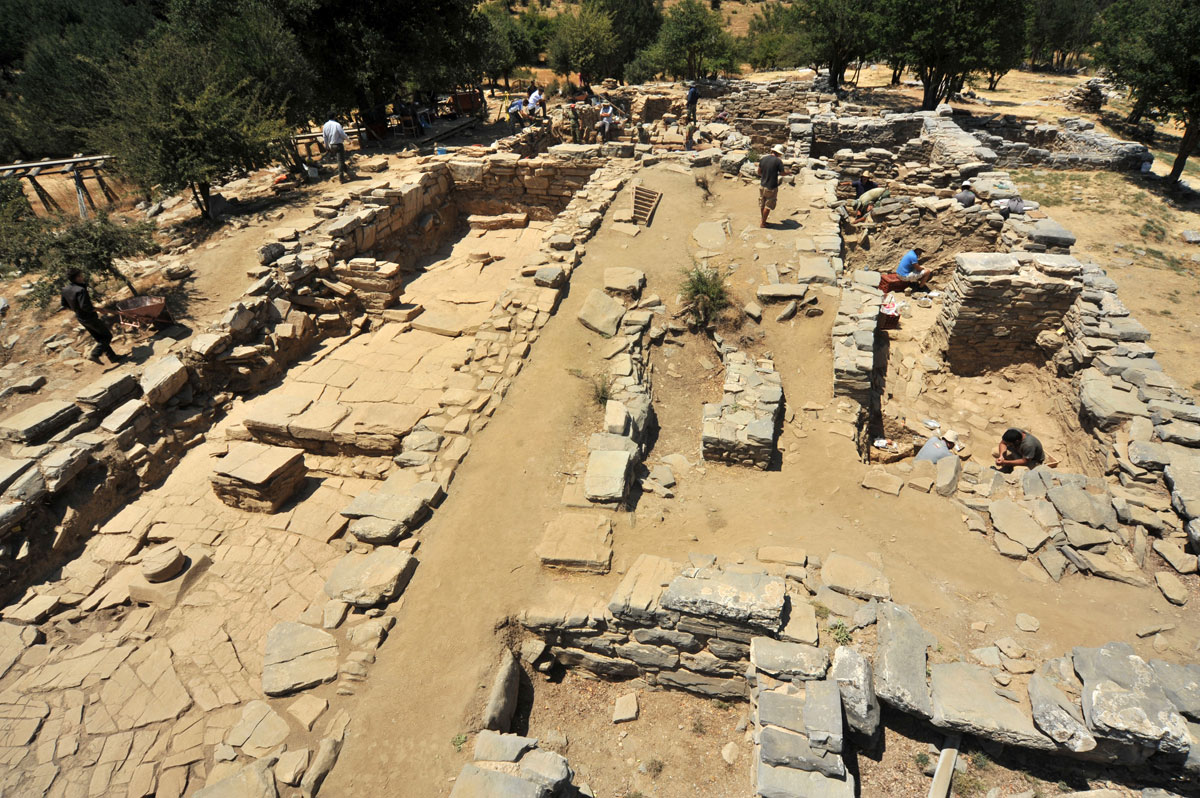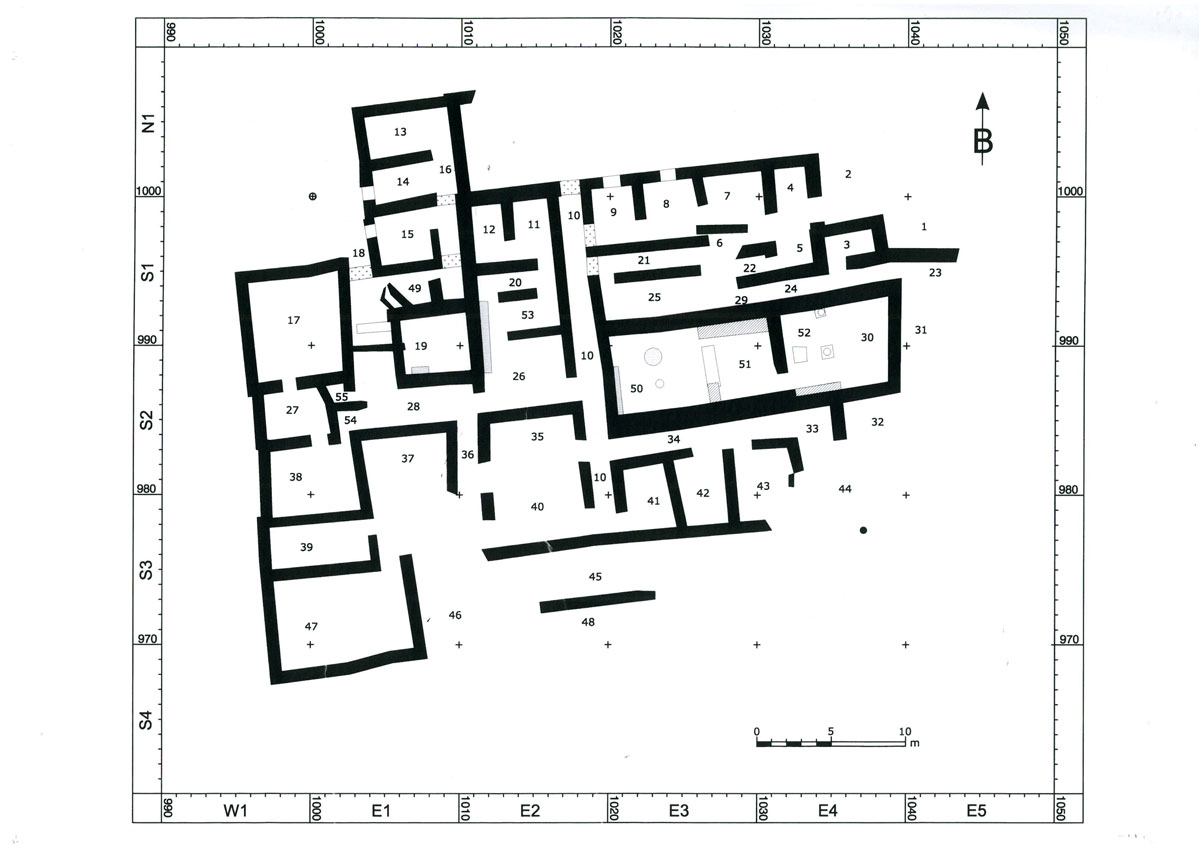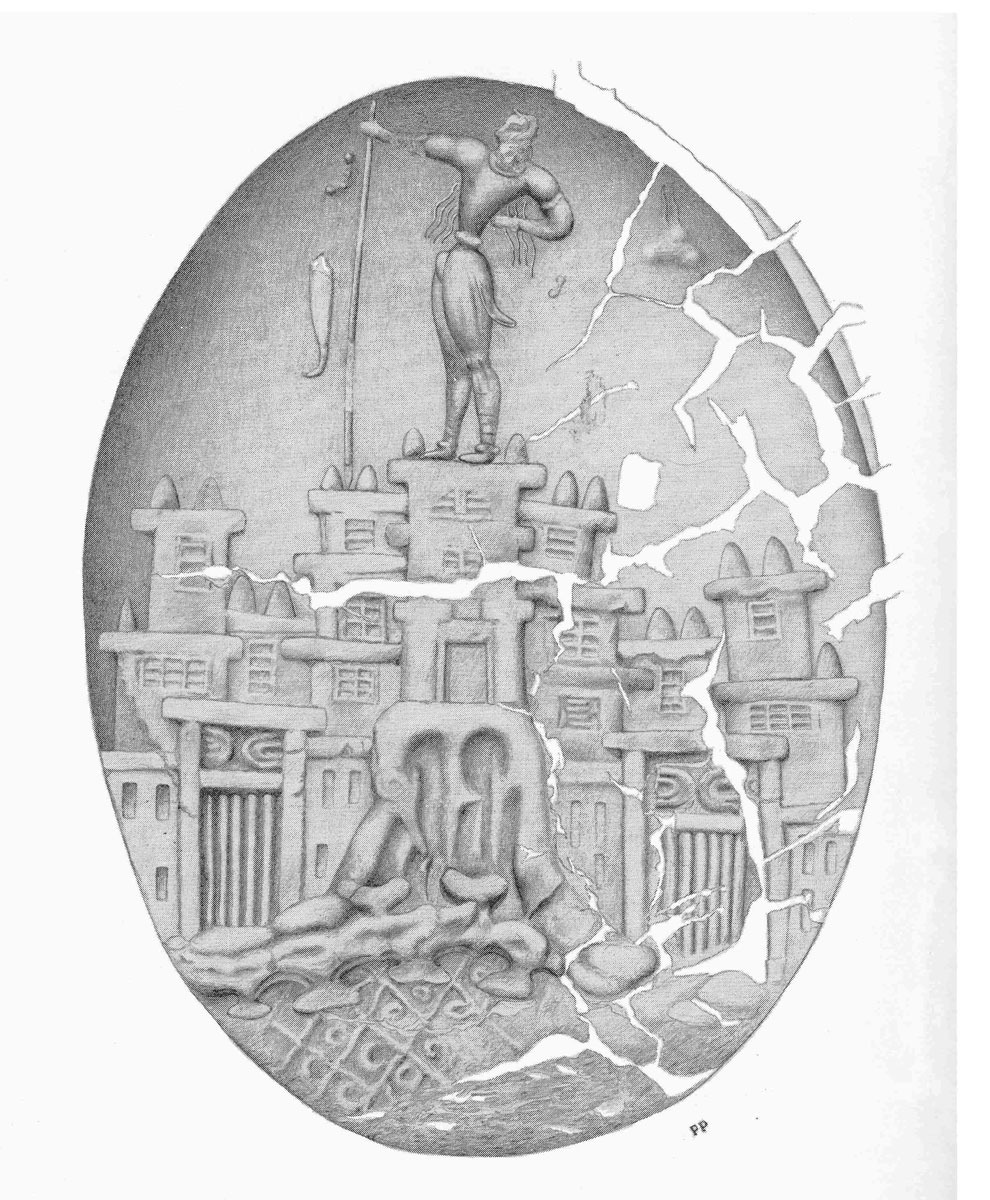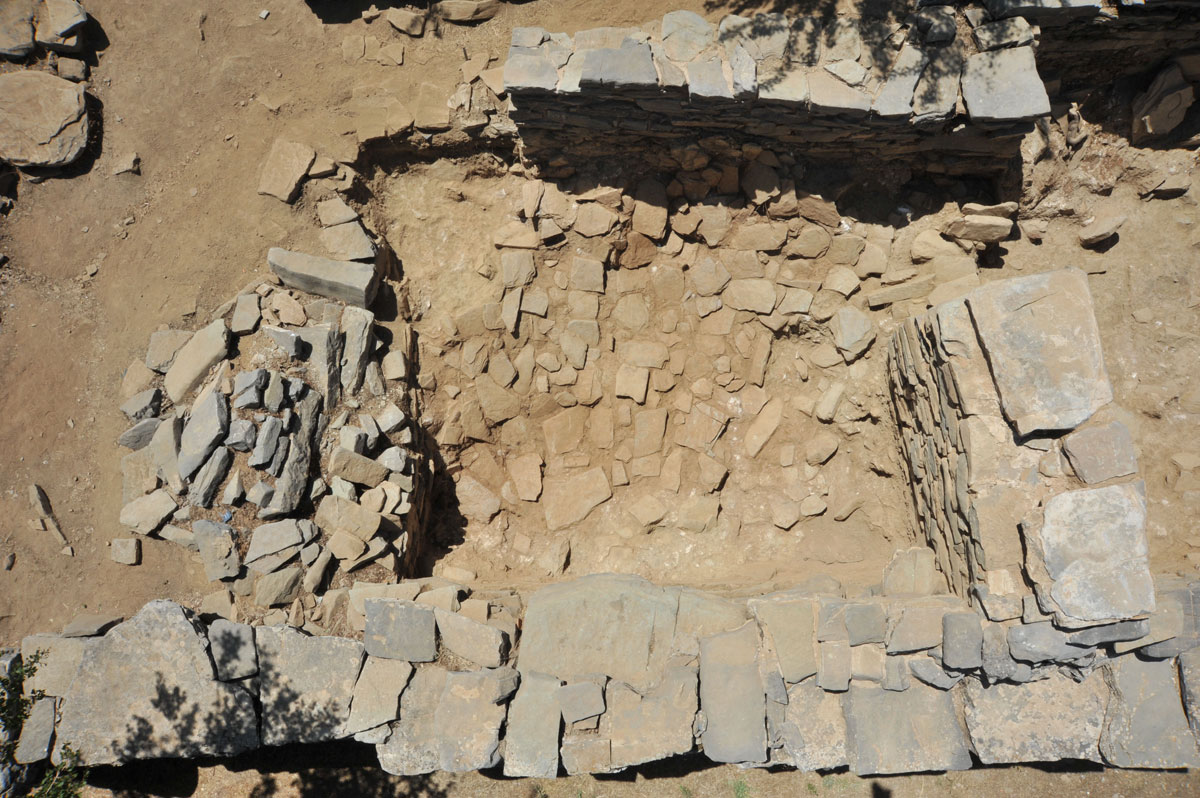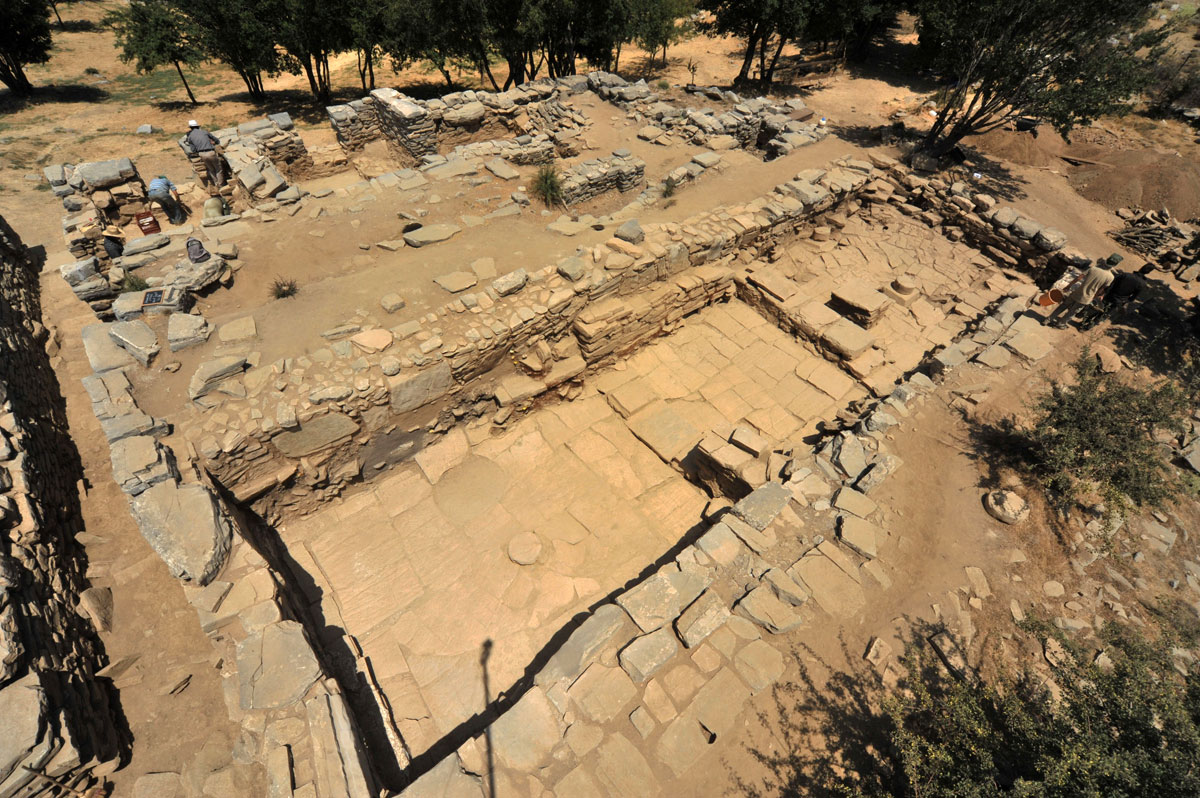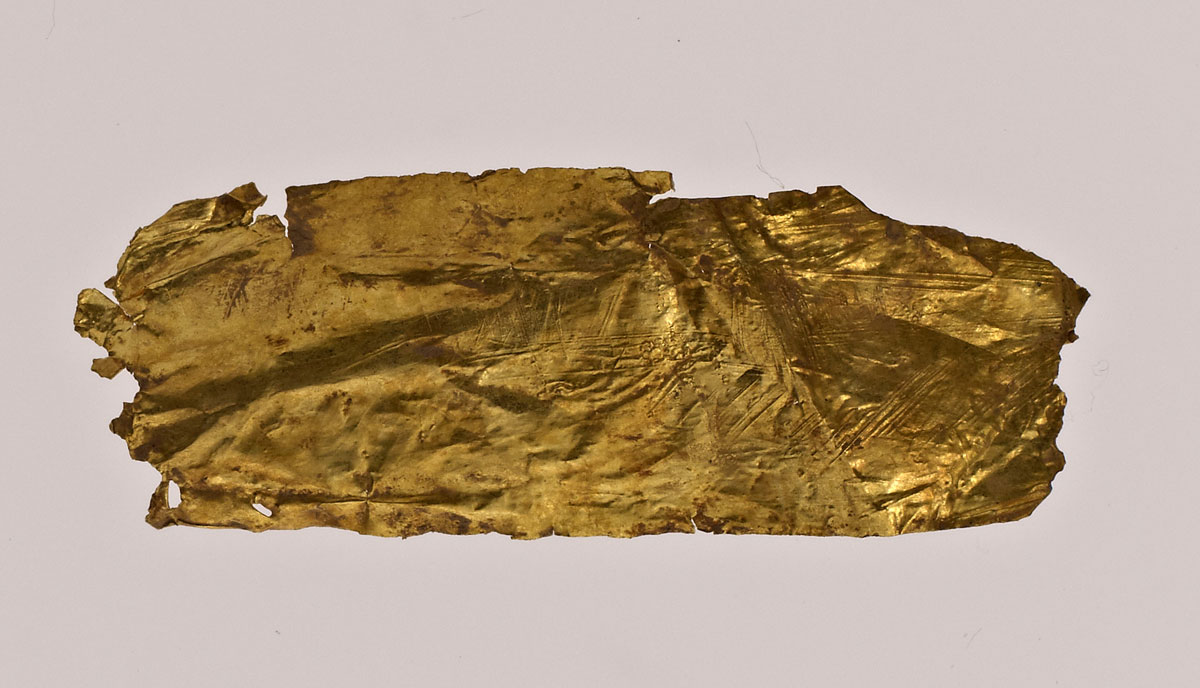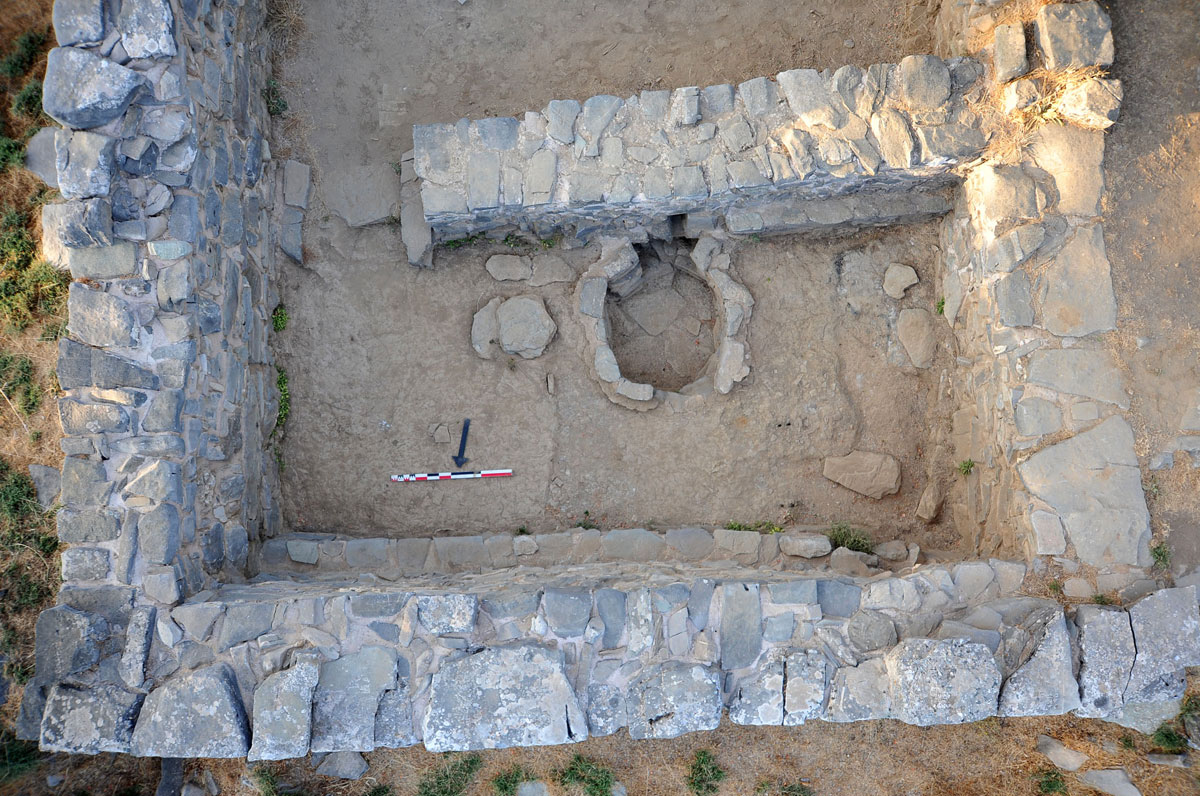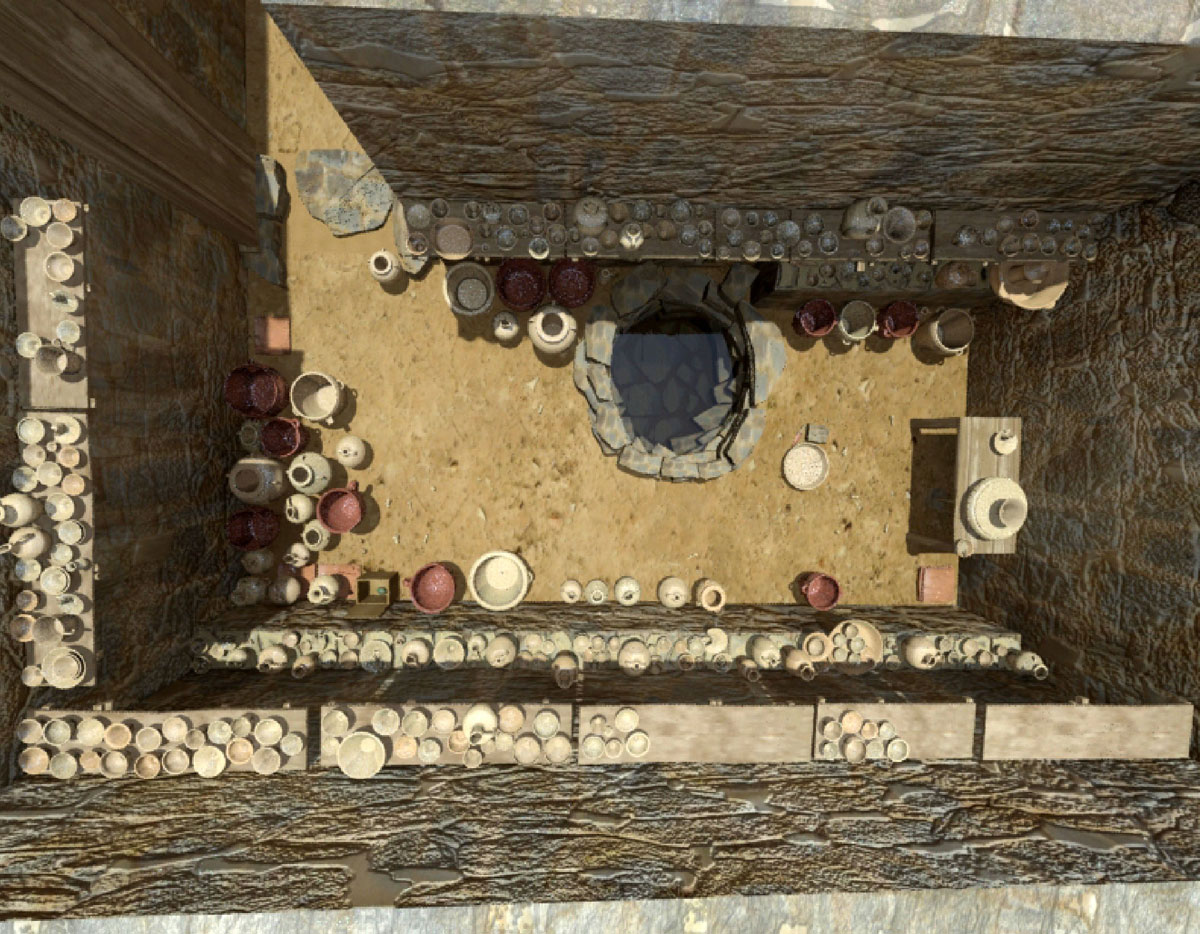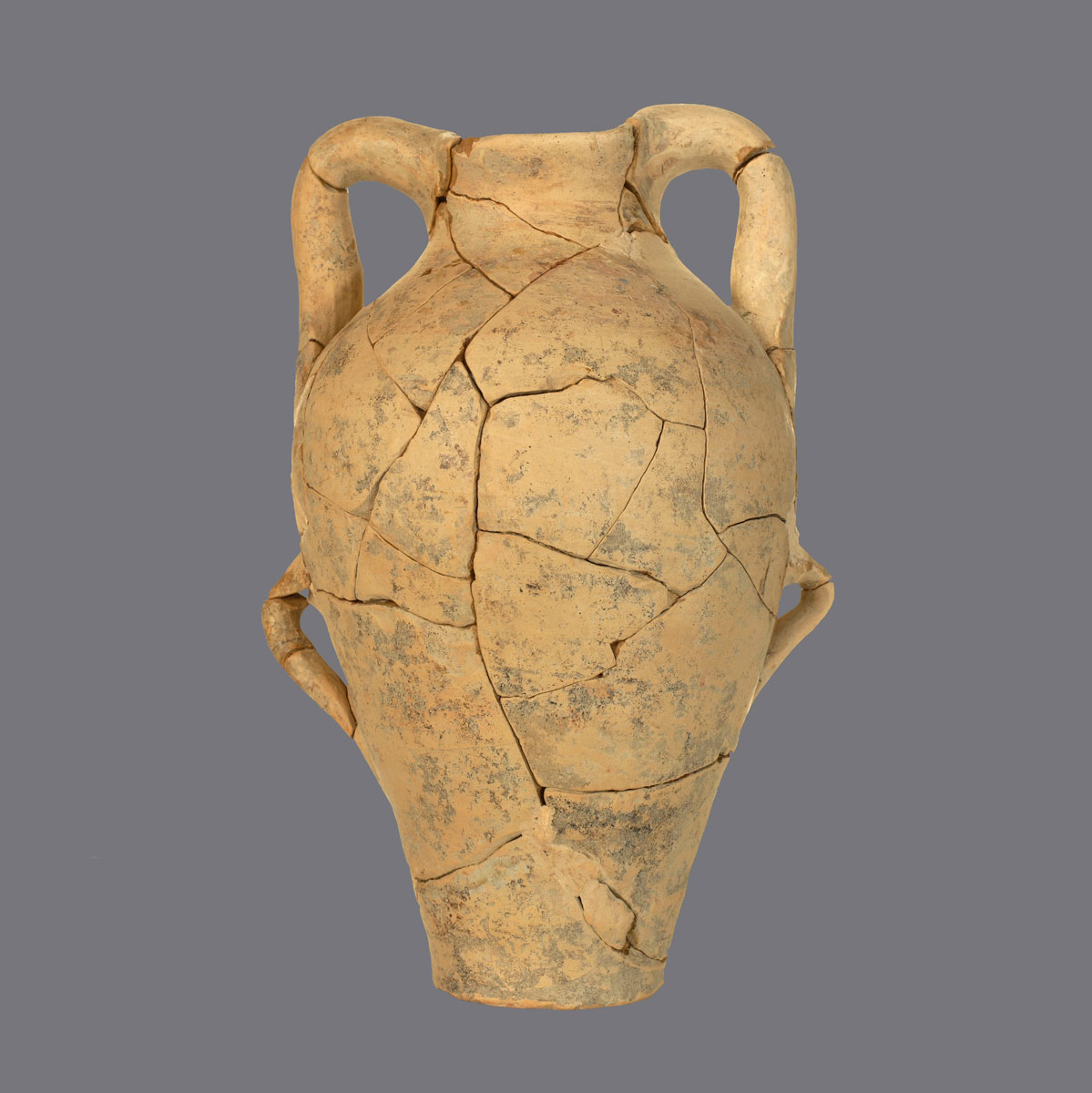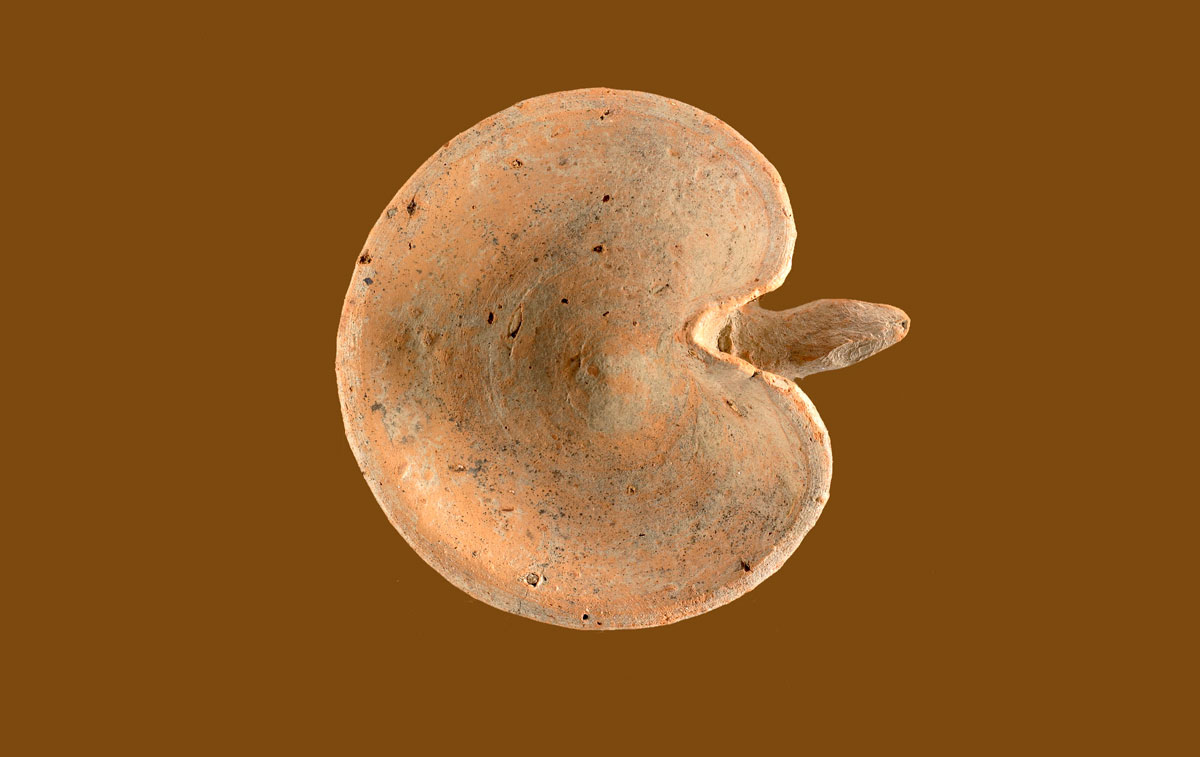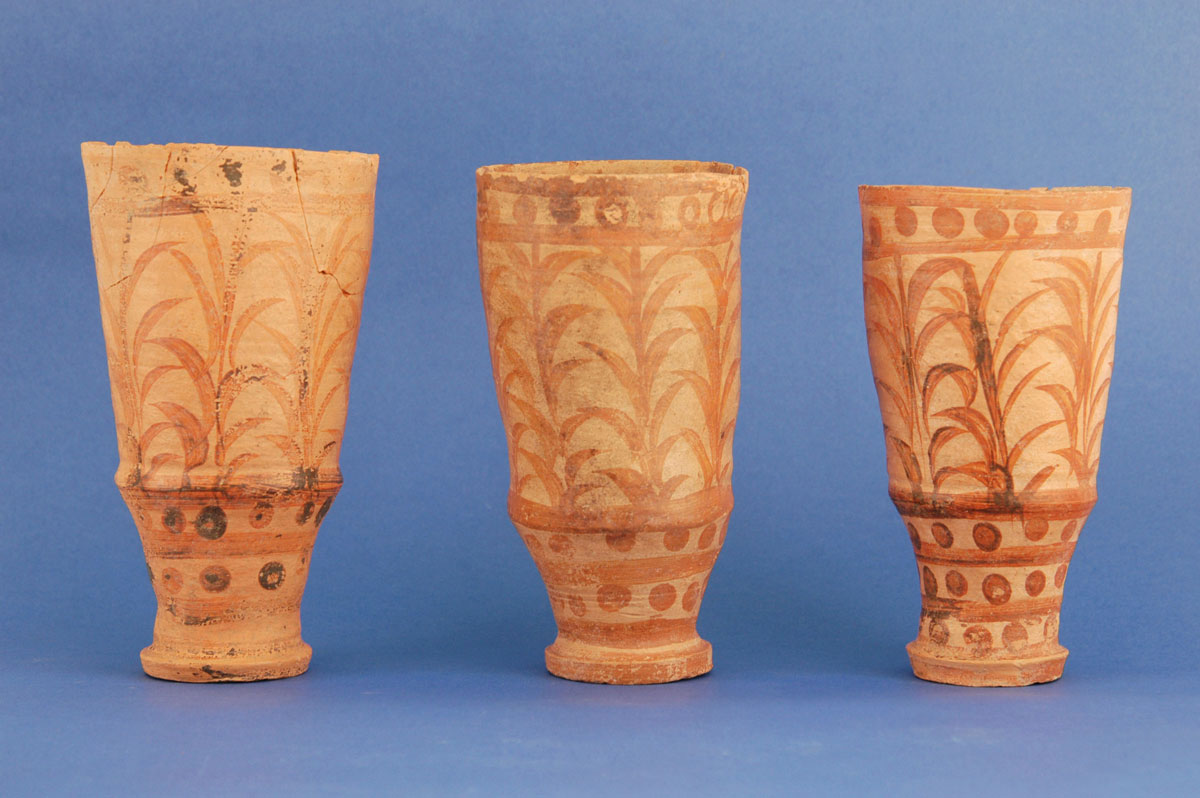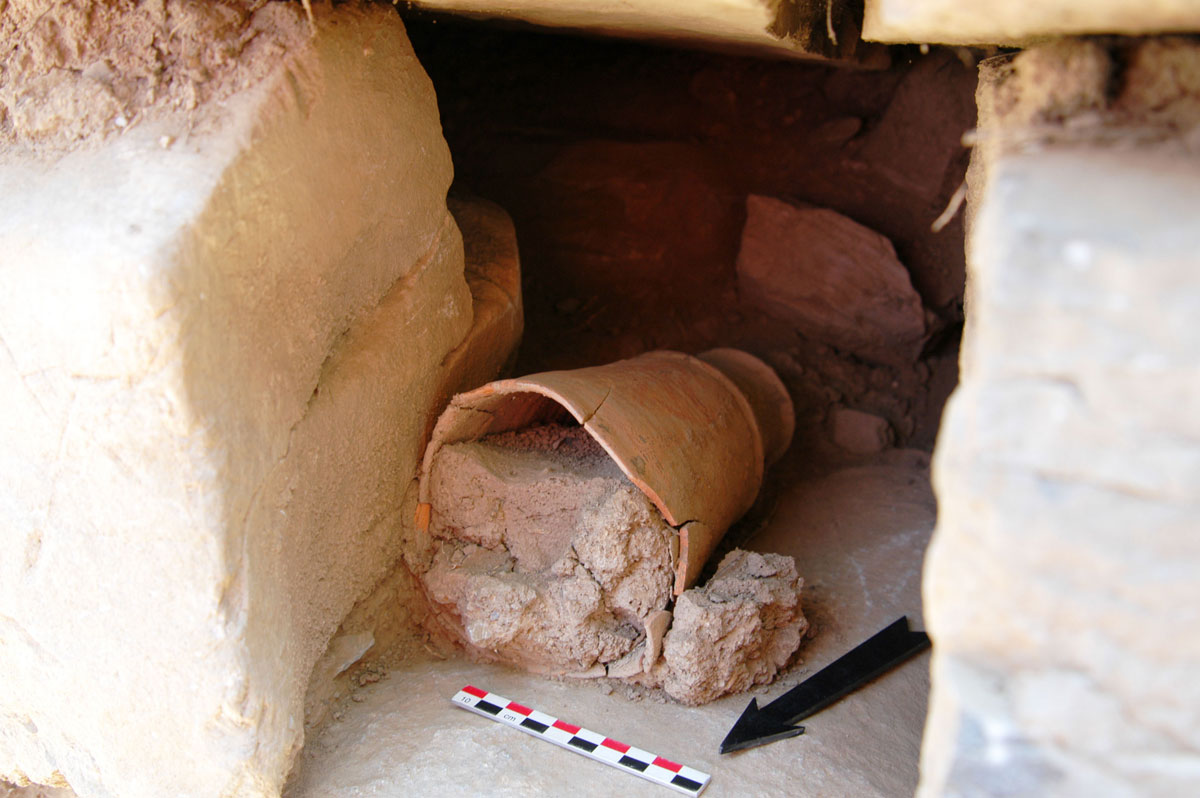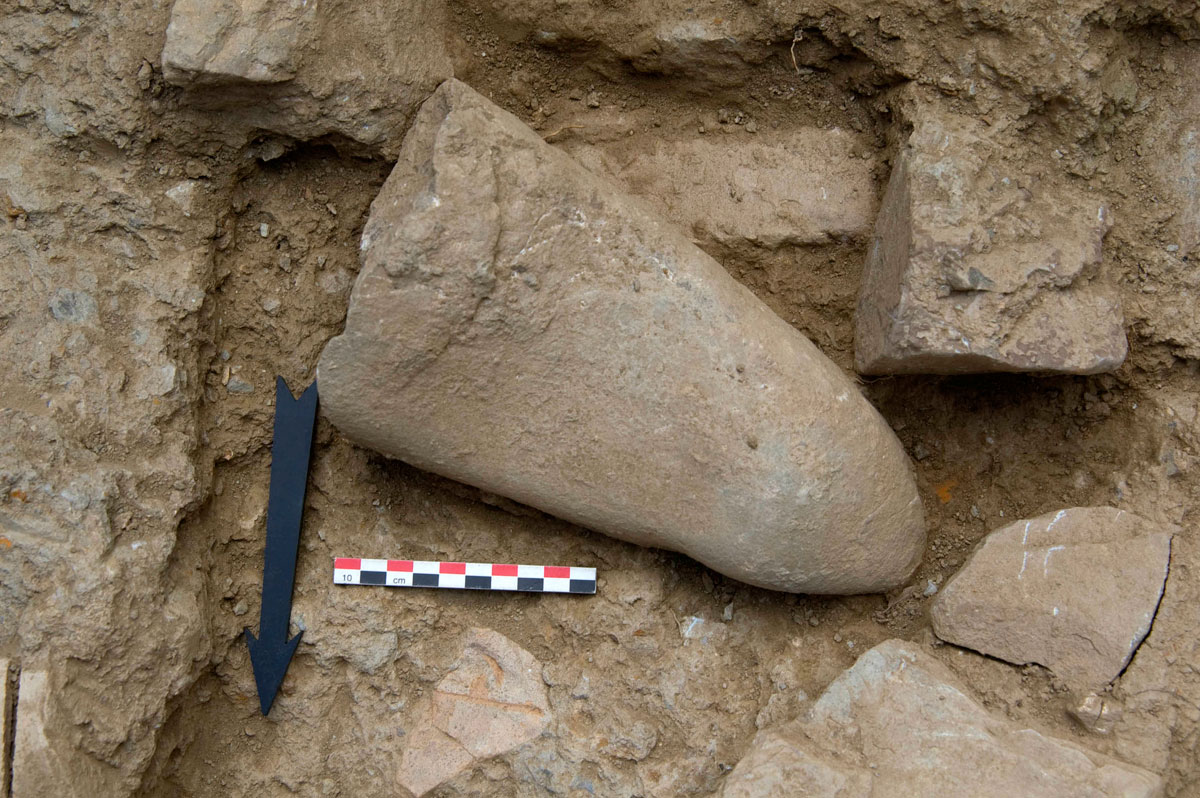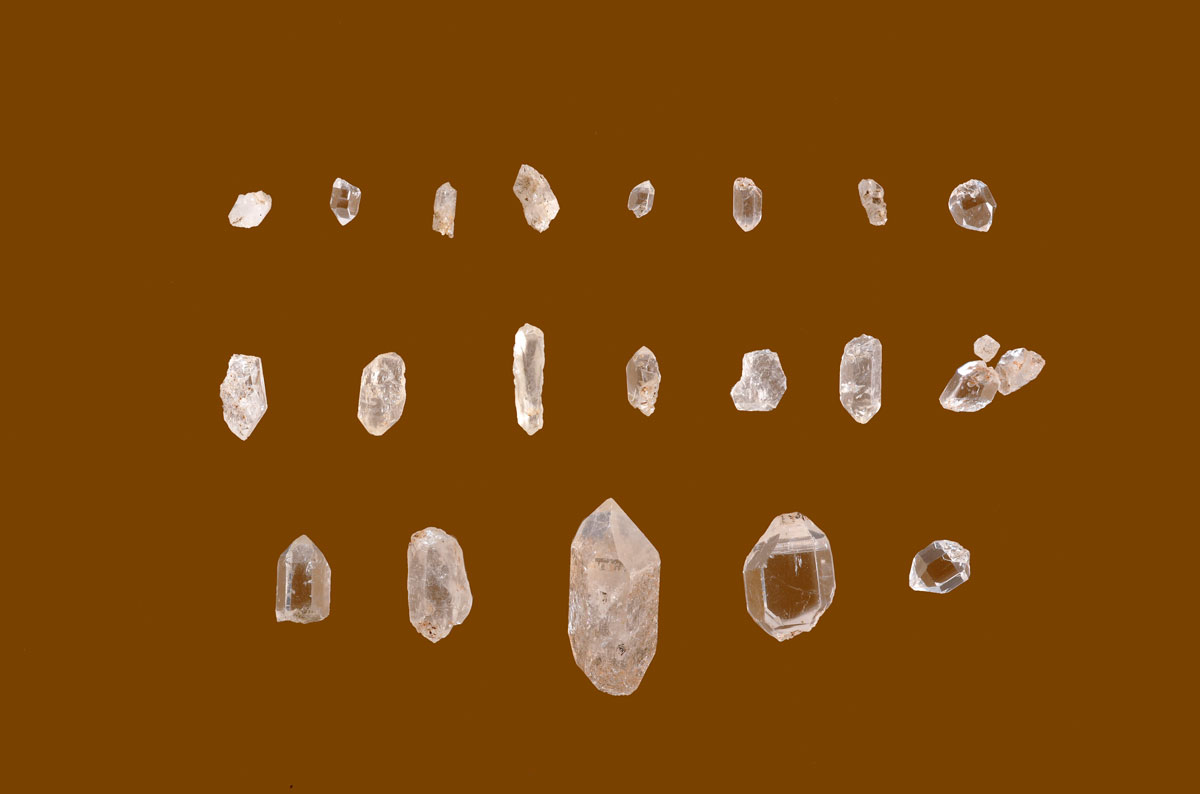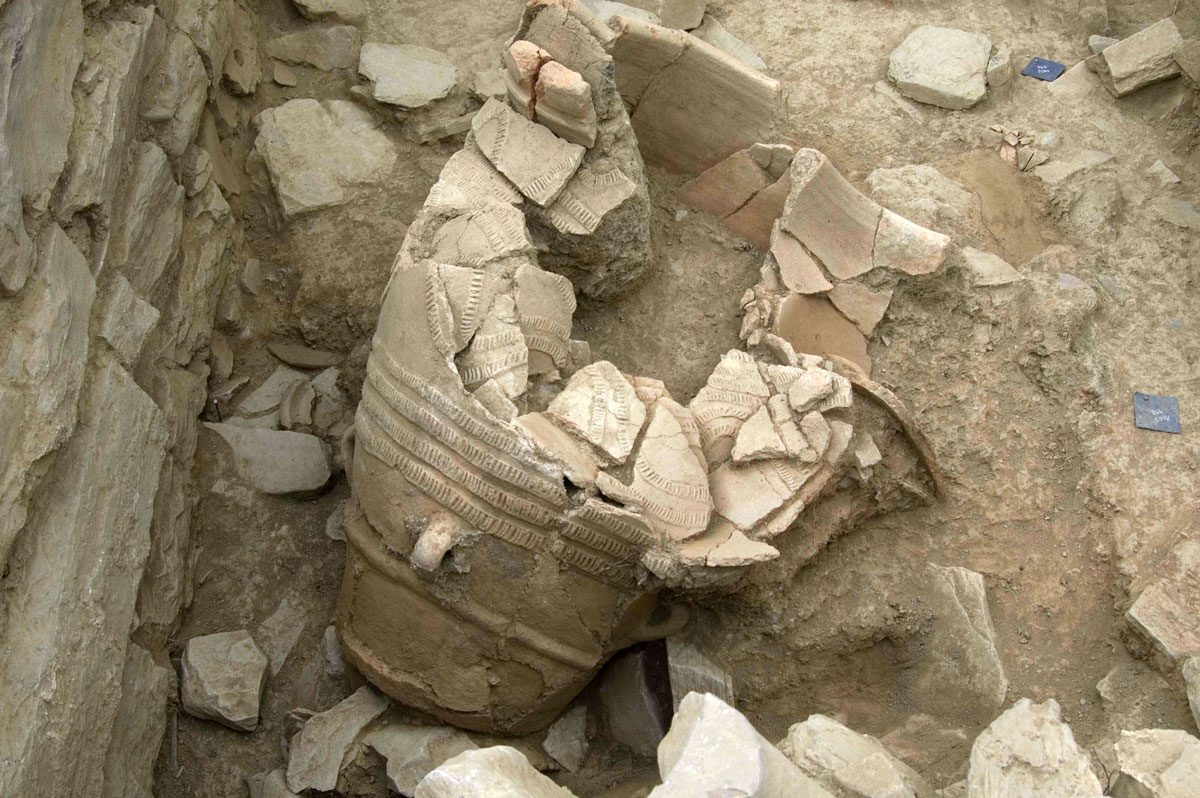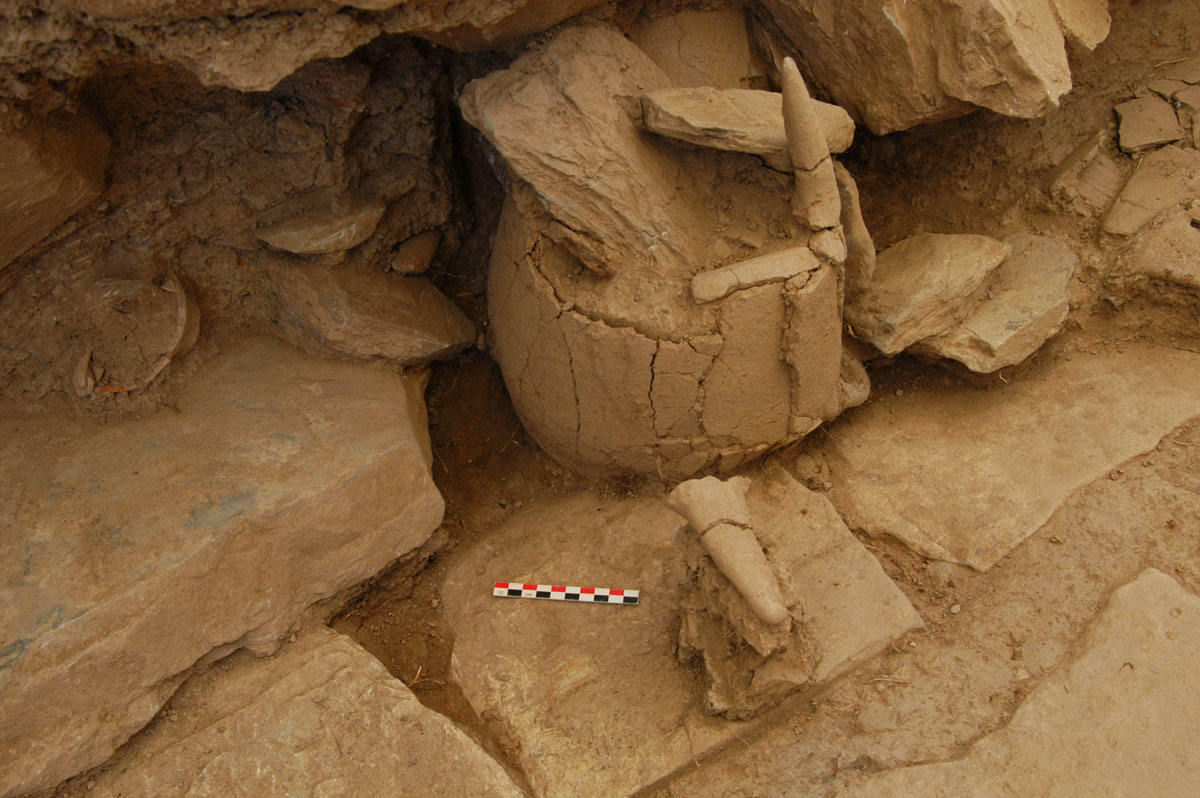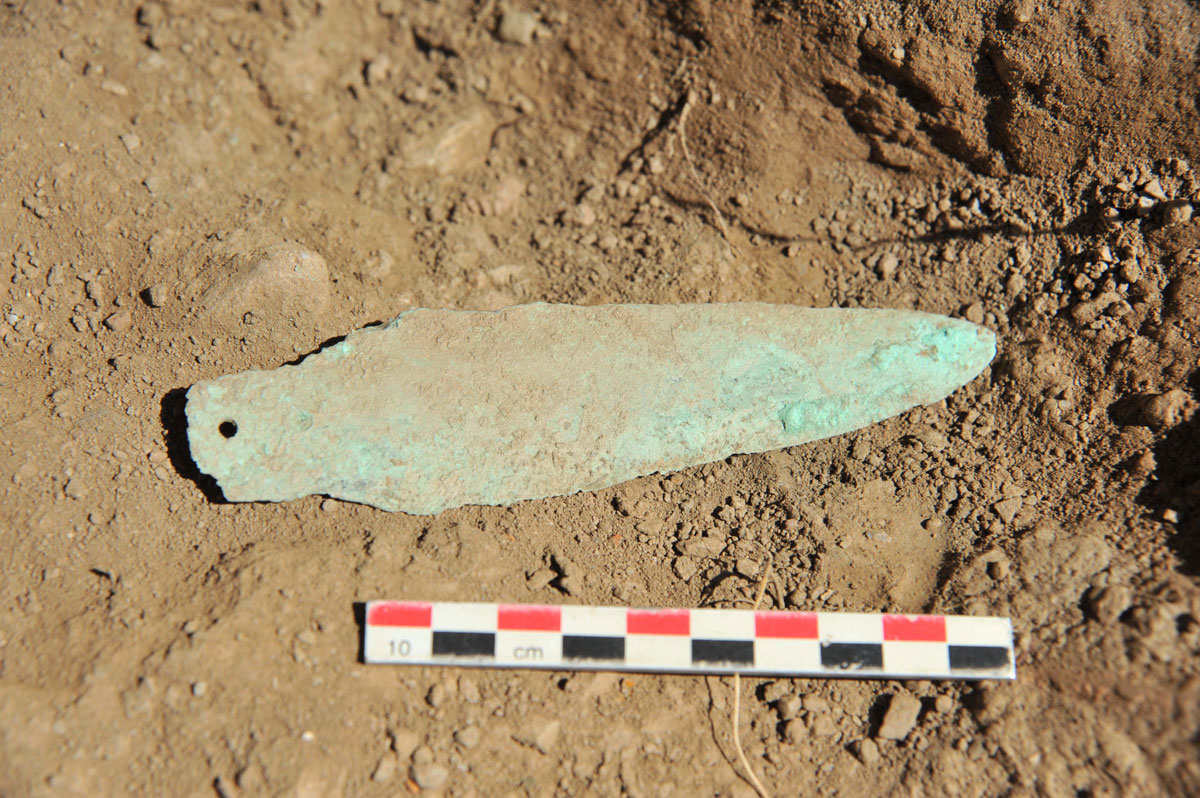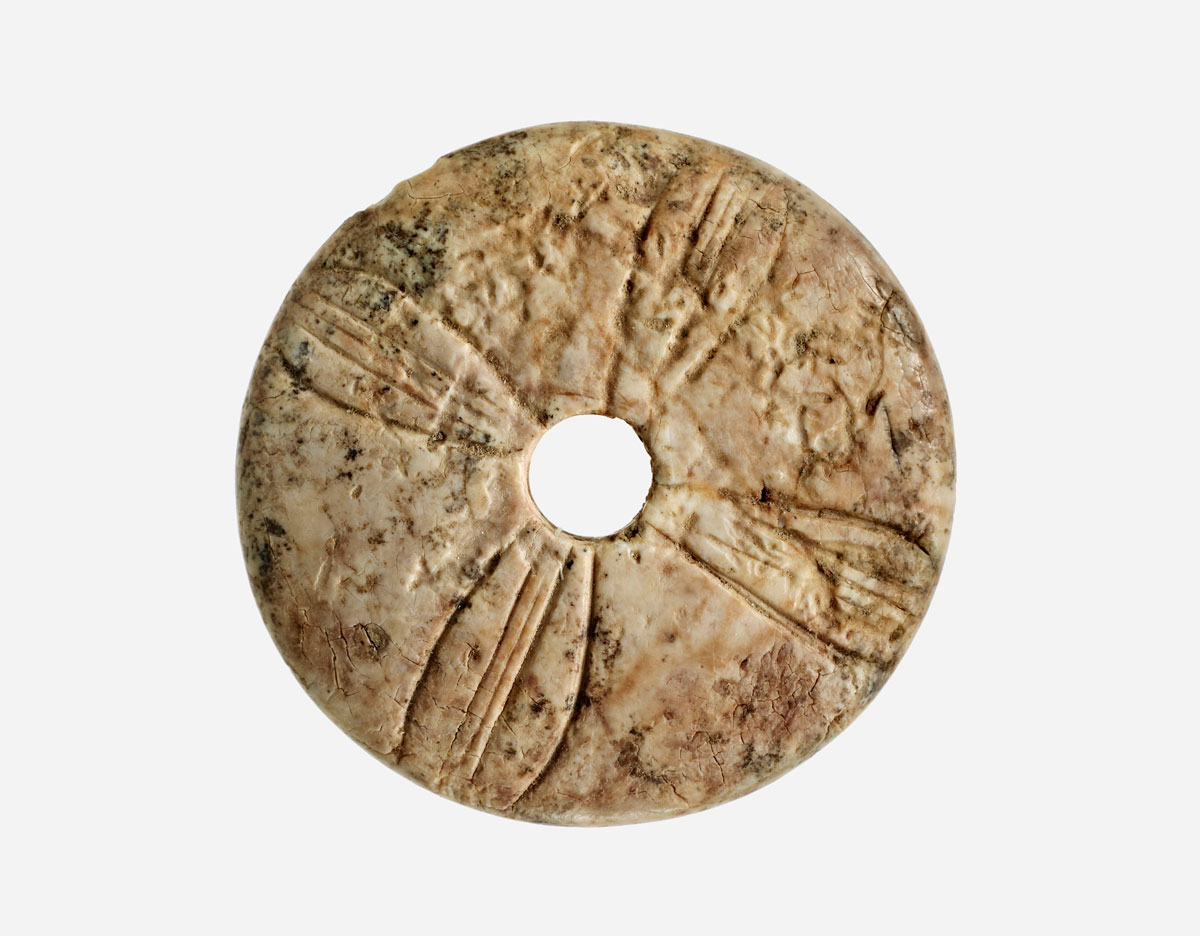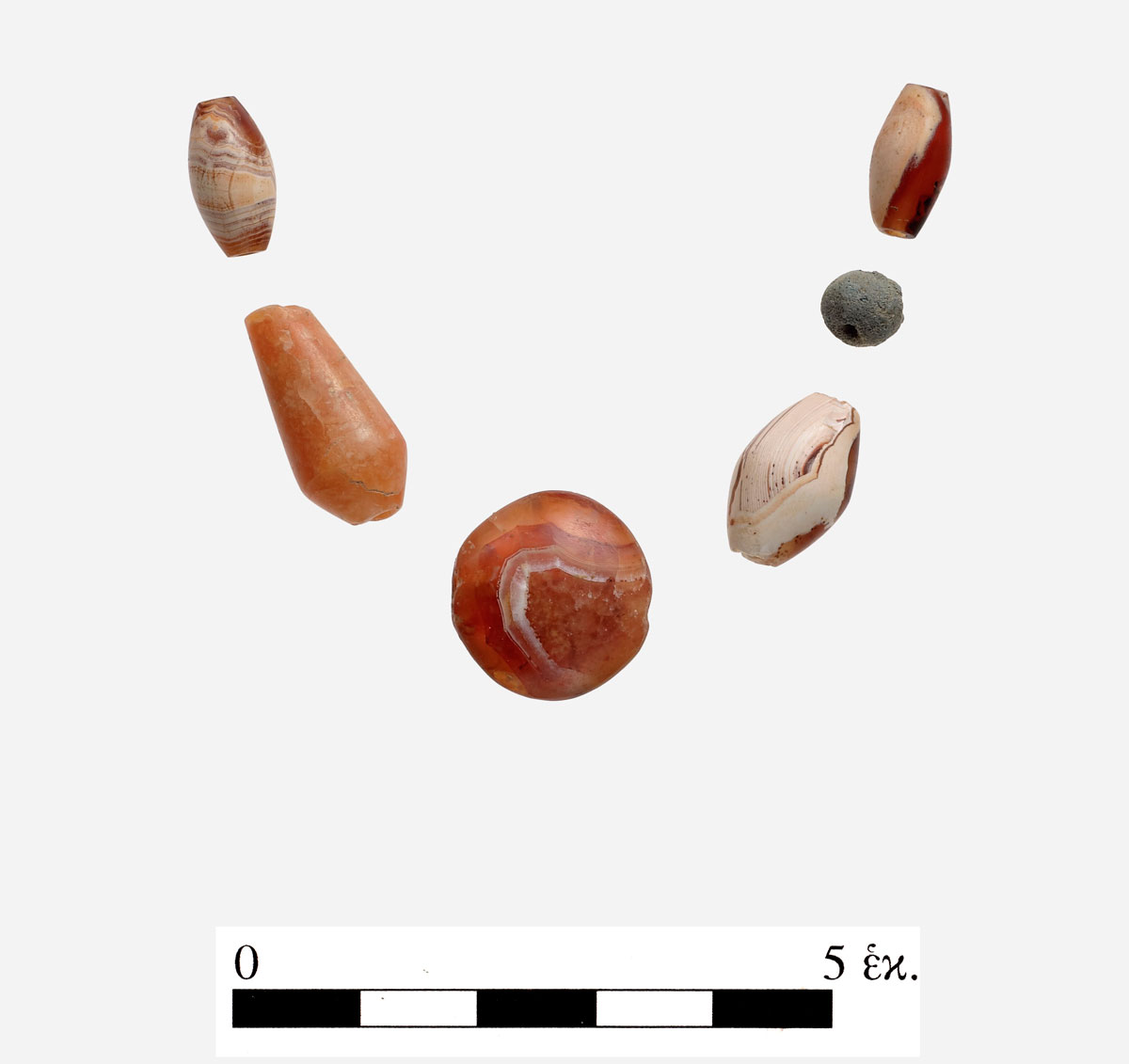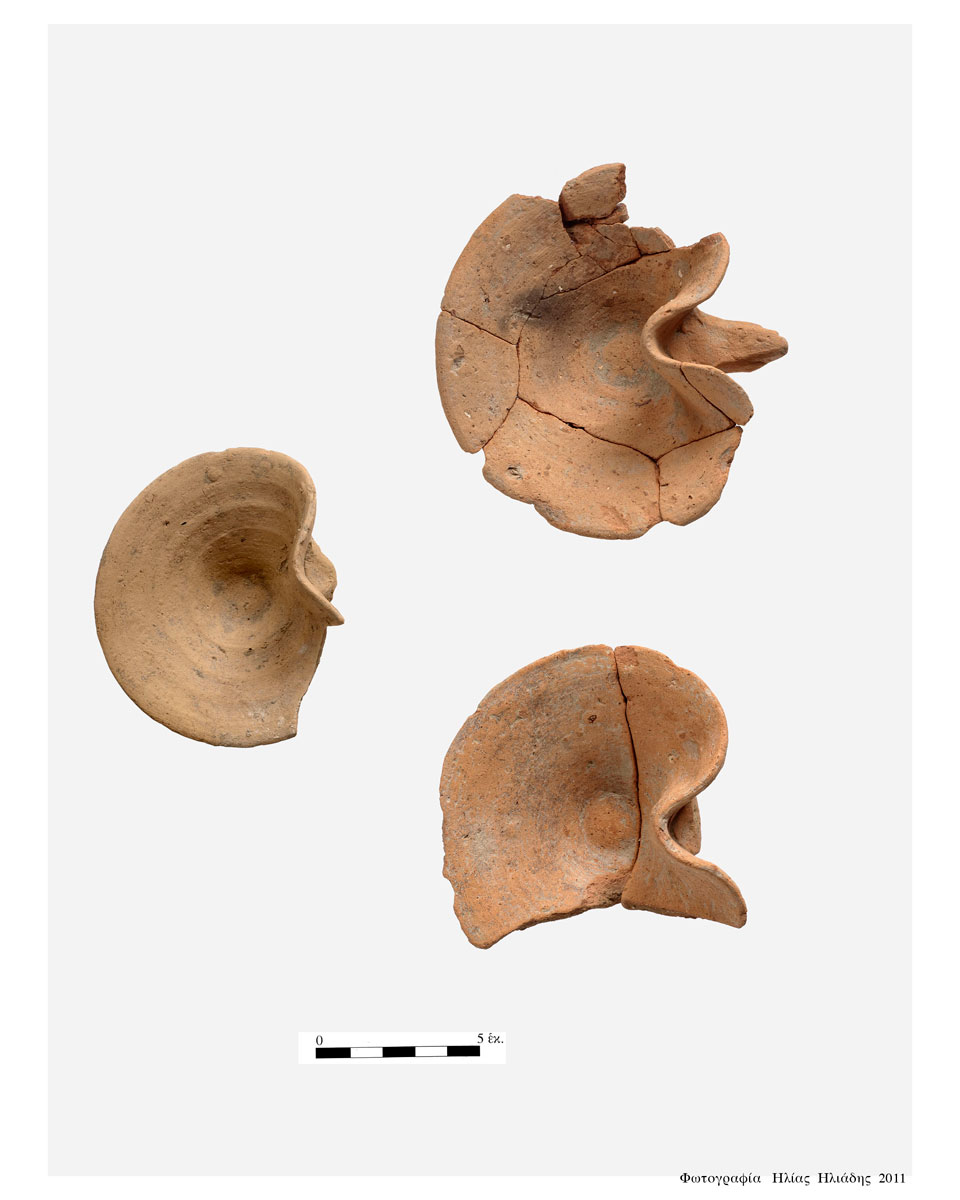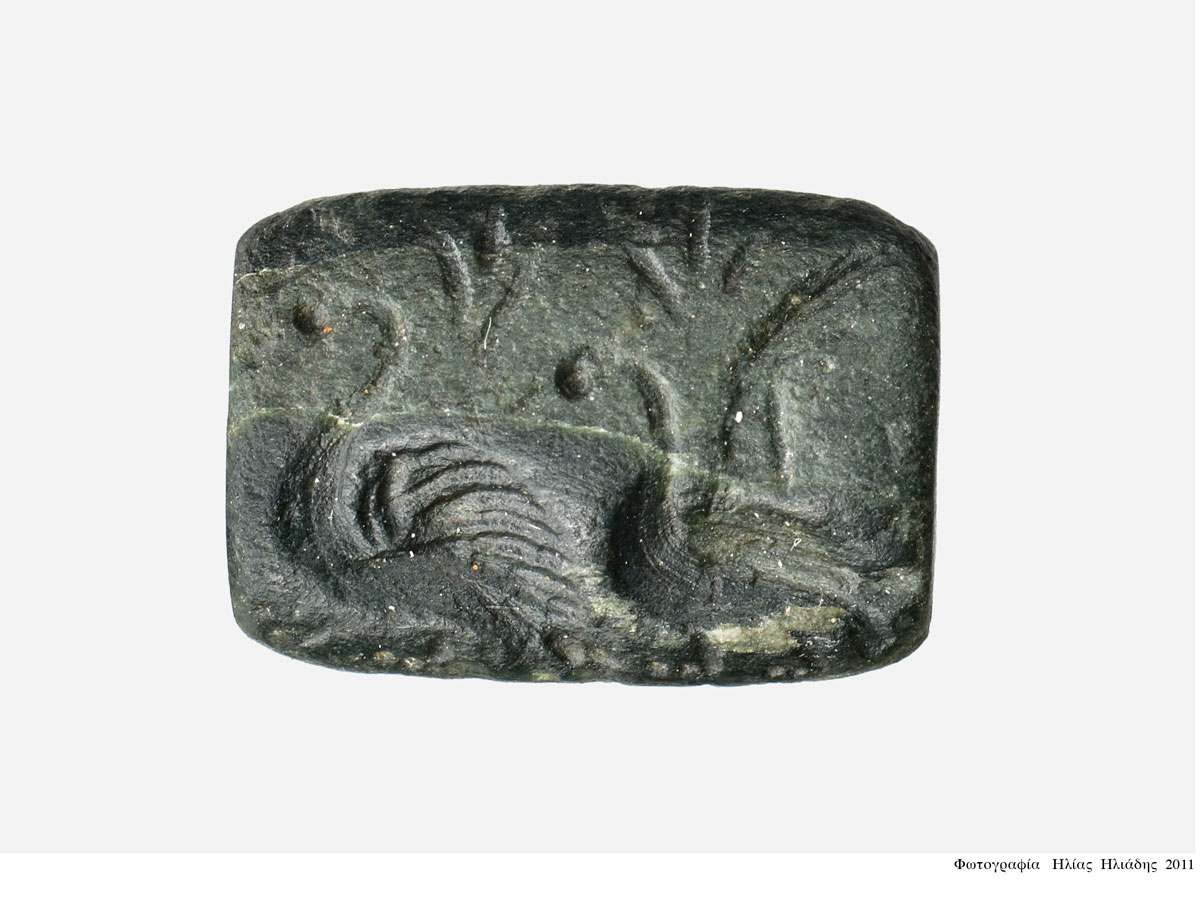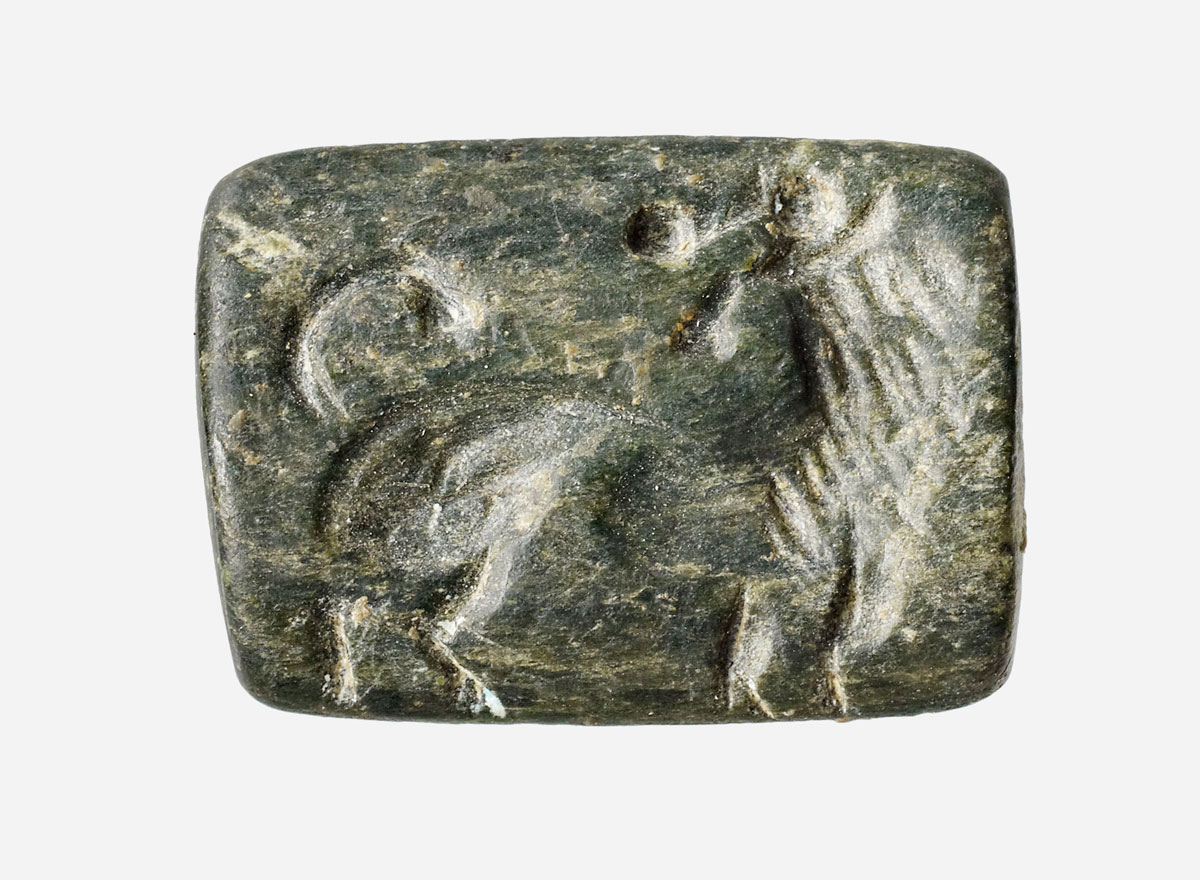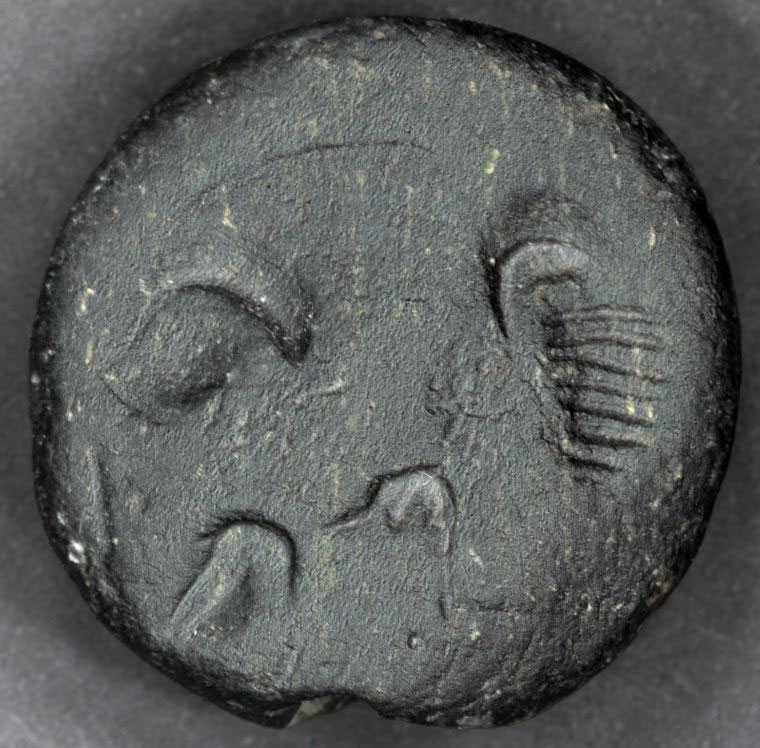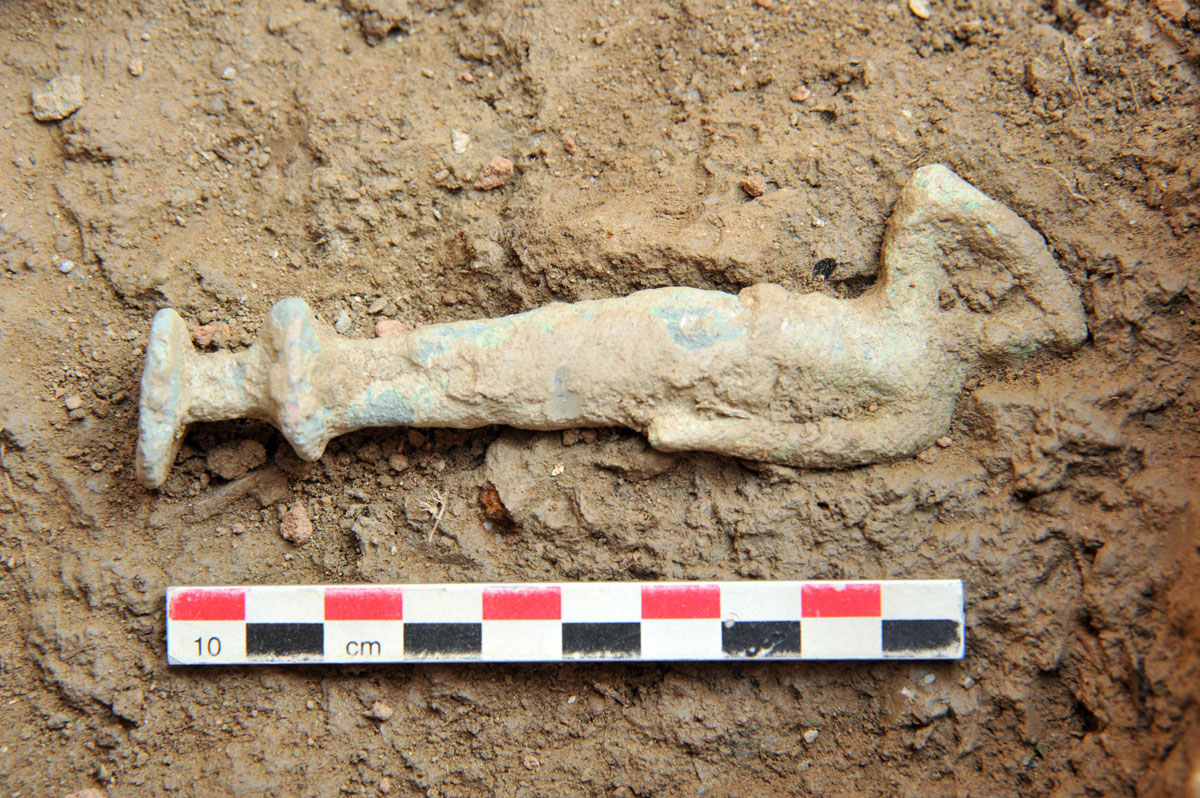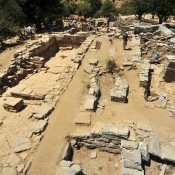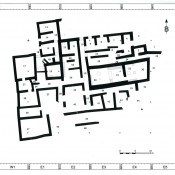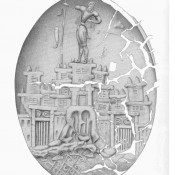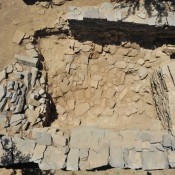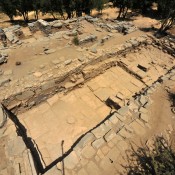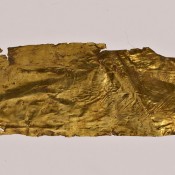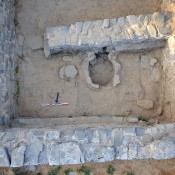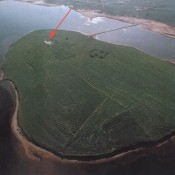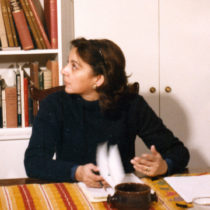In a personal note, Yannis Sakellarakis had written: When I began the excavation at the Idaean Cave, in August 1982, Yahoudis, a shepherd from Anogia mentioned that he was pasturing his sheep at Zomitho… Zomithos… Zominthos. Instantly, I heard a prehellenic word, as indicated by the suffix -inthos; a Minoan word.
And it was not only the word Minoan. The site was Minoan as well. Walls, barely visible above the ground and hidden under the vegetation were forming rectangular rooms. Pottery fragments were scattered on the ground and the slopes of the hill. And the name of the place was still, after so many centuries, Minoan.
The walls are unearthed, the plan is drawn and the digging tools go deeper into the rooms. The excavation is progressing at the pace dictated by the mountain, but also by the scientific needs of the project. An entire building comes to light, at 1,200m on the Psiloritis Mountain.
The building itself is unique. The fact that Minoans, who ruled the seas and had great palaces and extensive coastal and lowland settlements, as well as numerous ports, decided to build and maintain such a building at this high altitude, leads Minoan archaeology into new routes, highlighting the aspect of the mountains.
With more than 55 rooms at the ground floor (fig. 2), covering an area of 1,600 square metres, with a second or a third storey in its greatest part, it is the biggest Minoan settlement known to date on the mountains.
The building is bulky, heavy and hard (fig. 1) and looks as it was born from the Idaean Earth. And the archaeologists, who gradually reveal the walls, accentuate this impression. The excellent and readily available resources and the knowledge of Minoan craftsmen resulted in one of the best preserved Minoan buildings with walls still standing, 3,500 years later, at a height over 2.50m. Until a devastating earthquake demolished its walls and shattered its floors. Although the life of the building ended, the place remained alive in the coming centuries. People returned, passed by and settled. Mycenaeans, Romans, Byzantines and Venetians. All left their traces at Zominthos.
Numerous vessels of various types and shapes, bronze tools, a knife and a pair of tongs, some stone tools, a ceramic potter’s wheel, a basin and one construction that resembles a kiln led to the identification of a ceramics workshop. Numerous cups and cooking pots, lamps and incense burners, jugs and jars, some of which are decorated, were found on the stone benches or fallen from the wooden shelves. Vessels were found even in niches. Were all these vessels made for the needs of Zominthos or were they intended for the passers-by who were heading to the mountains and the Nidha plain?
Storage spaces are also present. Two of them, which are semi-subterranean to retain the dampness of the earth, have been excavated so far. In these rooms, which are quite compact, we found large pithoi with elaborate decoration. In the same place, a pile of burned wood was also identified.
It is obvious that Zominthos’ inhabitants were storing essential goods for their everyday needs; wood to be used as fuel for the hearths, which would have kept them warm and would have facilitated cooking. They were also storing food, such as barley, legumes, cheese, honey and fruits, and of course animal fat for lighting and maintaining their products, since they lacked oil and salt.
Among the areas of the building there are those of gatherings. They are small spaces with large windows that allowed light to enter the interior and illuminate the walls, which were covered with white or coloured plaster of excellent quality; these are still preserved at the height of the walls. The quality of the plasters, often decorated with coloured bands, and obviously with other motifs as indicated by their polychromy, indicate the secular nature of these rooms.
In the accounting records of the Linear B tablets found at the Palace of Knossos numerous sheep and shepherds are recorded. However, the land that these sheep were pasturing has always been a mystery. In which mountains the shepherds were residing during the summer months, when they returned from the lowlands where they were dwelling during winter months? In which land were the lambs breed for their meat, where the sheep were fleeced for their wool, and where goats were milked?
But it is not only animal husbandry that is fostered by the wealth of the mountains. Forests, were also providing significant resources, such as timber suitable for shipbuilding and furniture, as well as herbs with aromatic or medicinal properties, such as the dittany of Crete. These were products, probably needed even more than the olive oil of the Cretan plains, especially in the market of Egypt and the East. Apiculture, minerals as well as ice should have been equally important.
The location of the building certainly was not a random choice. Most of the paths that lead from the north coast of Crete to the mountains converge at Zominthos. You will pass by Zominthos if you want to go anywhere higher to the Psiloritis Mountain, regardless of your final destination; the Nidha plain, the Idaean Cave, the Ascension or the Holy Cross churches.
Yannis Sakellarakis was saying that Zominthos is the most important excavation of his life. This was quite odd for an excavator, who had revealed such a wealth of finds. It seems that he envisioned the wealth that was well hidden and was gradually unearthed in the last two years of his life and especially after his death. He also planted trees in the bare land surrounding the site to make it look as it might have been in antiquity; this is “Sakellarakis’ forest” as the local people call it. The hawthorn (trikokia) of Zominthos which dominates the landscape near the entrance of the site was declared “monument of nature”.
The Zominthos Central Building is certainly larger than the usual Minoan ‘villas’, occupying an area of 1,600 sq.m, also surrounded by an extended settlement that exceeded 4 acres.
Minoan ‘villas’ are usually built in the Late Minoan IA period (1700-1600 BC). Their development is the result of the political and economic organisation of the palaces, and they are used over a short period of time to serve specific purposes under the control of the great palaces, such as Knossos.
The Zominthos Central Building located at “Alones” is far away from the large Minoan centres. It was built simultaneously with the first palaces and continued to be used –with short interruptions– until more recent times.
Remains of the Old Palace period were found in many parts of the Building of the Neopalatial period. Most significant are these revealed at the top of the hill, in Rooms 50-52 and 30.
The Central Building has many elements that also characterise palatial structures. For example, its orientation in the Neopalatial Period is North to South, whereas in the Old Palace period this slightly differed. Another element is the indentations in the western part, as well as the courtyard on top of the hill, and possibly another one north of the facade, as suggested by the paved floor revealed in the first field seasons in 1983.
The structure of the building, its orientation, its robustness and of course the various finds indicate that Zominthos was a major centre; modern archaeologists would have called it a ‘Mountain Palace’.
Location
Zominthos, at an altitude of 1,200 metres (1,187 metres to be exact) is located even higher than the village of Anogia, which is situated 10 km lower. Zominthos is a unique case of a Minoan settlement at such altitude, except the Minoan “refuge-sites” of the Late Minoan III period or some peak sanctuaries.
At a lower level, in the northeast slope of Psiloritis, several sites, which might have been stopovers towards Zominthos, have been revealed; the most important is Sklavokampos.
Sklavokampos’ sealings indicate the existence of an administrative authority in the mountains that starts at a high altitude and continues to the plain. They are probably part of a chain of relationships that suggest the movement from/to the sacred Mountain or from Zominthos to the plain. Therefore, the altitude where Zominthos is located is a very important aspect of this settlement and is vital to identify the reasons for this choice.
The overall structure of the Building shows that it was not a seasonal habitat for shepherds, but an elaborate centre for people with a prominent role in Minoan life. Certainly, animal husbandry, as shown by the Linear B tablets of Knossos, as well as other related activities, such as weaving, cheesemaking, and the wealth of the forests and their herbs, had a fundamental role in the existence of a large centre, such as Zominthos. The finds however indicate that the location was not the only reason of its existence.
Zominthos is located on the way to Ida. Specifically, it is situated at the crossroad that leads to the Nida Plateau and the Idaean Cave with a northern route from Sklavokampos, a northeastern from Knossos and Krousonas −this is probably the route that Plato followed in his “Laws”− a northwestern route from Axos and a south from the Messara plain.
Sakellarakis’ recent research in the Idaean Cave showed that its habitation was initiated in the Neolithic period, while it functioned as a ritual centre in the period of the first Minoan palaces. The Priesthood of the Idaean Cave consisted of a powerful elite who were managing the wealth of the mountain and the sacred cave. It is believed therefore that the management of the cave and of the wider region did not only last for about three months, which is the time that weather conditions allowed. This means that another centre, which was accessible by the priests and the believers, should have been in use for the rest of the year. On condition that weather conditions have not changed much in the last millennia, Zominthos is located at a place where access is possible all year long. The view of the interplay between the sun, the fog and the clouds at the site create an ideal scenery for the various rituals acts. The relationship between Zominthos and the Idaean Cave has been noted by Y. Sakellarakis since 1983.
Water is also an essential element for a settlement. In the wider region of Zominthos there are three springs, one of which is called Zominthos. In the modern era there was a mitato and a threshing floor (aloni) located within the fenced archaeological site. The latter most probably gave the name to the place (Alones), where the Minoan settlement is located. The low hill, the pasture land and the small plateau favour a permanent habitation.
The excavation by Y. Sakellarakis, which is still ongoing, revealed this unexpectedly important building, covering so far an area of 1,600 square metres, and having two or more floors. In its original form it might have resembled the building depicted in the well-known sealing from Chania – master impression (fig. 3). The building, which was founded in the Late Minoan I period (c. 1700 BC) is made of worked local limestone. It was built on the remains of an older structure, parts of which are visible in various areas of the building. The excavation is in progress and more will be revealed soon. However, a brief examination of the areas that have been unearthed so far, can provide an idea about the overall character of the building, as well as its function as an administrative centre during the Minoan period. The Central Building is not isolated, as recent research indicated that an extended settlement exists in an area of 4 acres.
The plan and the overall design (fig. 2) of the Central Building is the work of an experienced and intelligent architect who handled the peculiarities of the landscape wisely. Both the interior and exterior walls are built with large blocks of limestone often exceeding 1m in length. The internal doors have large openings up to 1m, while some walls in the interior are made of smaller stones and mud bricks. In some cases (windows, doorways) stones are dressed. The wood, which was primarily used in floor beams, columns and frames, is still preserved in good condition, though burned. The Building has elaborate interior spaces with frescoes, used as private living quarters or chambers for the elite (Rooms 7-9) (fig. 2), storage areas, stairways, kitchens, light wells, a courtyard, pottery workshop, stone workshop (rock crystal), probably one of metallurgy, places of worship or these used for gatherings (Rooms 28, 49, 50-52), and possibly a gatehouse. All areas of the Neopalatial Building are quite uniform regarding their construction, apart from the areas – mainly openings (windows, doorways), which were roughly closed, obviously after the disaster, which happened in the same period or a little later, in the Mycenaean period, as the pottery suggests. However, the Building was also visited in the Archaic period.
For a better understanding of the settlement a brief description of the areas investigated is provided below.
Exterior north wall
The exterior north wall was the first area that Y. Sakellarakis excavated in 1983, after the identification of the site in 1982, during the excavation in the Idaean Cave. The height of the walls which exceeds that of 2.50m, the windows and the main entrance add splendour to the facade, while the paving consisting of small and medium size stones might indicate a courtyard. At the base of the wall there was a crepidoma. The exterior surface of the wall had also traces of plaster, which might indicate that it was plastered. No “mason’s marks” were identified in the massive blocks of limestone used at the façade.
Numerous cups and also other types of vessels were unearthed not only outside the wall but also on walls and at the entrance, as if they were hurled from the inside by the strong earthquake.
From the main entrance at the North, a long corridor (fig. 2, 10), so far 11.55m long and 1.35m wide leads to the south rooms also having openings to the east and west parts of the Building. In the northern part of the corridor coarse ‘kylikes’, similar to these found in other areas –some intact and others in fragments– were found. This type, as it will become apparent below, had a special meaning.
The corridor (fig. 2, 10) separates the building into two wings.
East wing
In the east wing, the areas that were excavated (Areas 1 and 2) facilitated the entry to the northeast side of the Central Building. An entrance existed in the northeastern side, probably the entrance from Area 2 leading to the blind Room 4, in which the threshold is preserved. Obviously there would be other entrances as well at the south side as indicated by the evidence.
One important room is the ‘lustral basin’ (Room 3), which is quite small and resembles the characteristic shape of such rooms. Its thick walls are plastered with red and white mortar. Part of a conduit was found at the western part, as well as a series of stones in semi-circular arrangement, which might have encircled a vessel, possibly a basin, a usual item in such rooms.
Room 7, which had at least two storeys, is extremely interesting since it preserves the floor of the upper storey which is made of schist slabs (fig. 4). This floor, with its slabs fallen diagonally with S-N direction, is quite a unique find with parallels only at Thera. This room was lavishly decorated with fine plaster of light blue, red, black and orange colour. Many coloured plasters were also unearthed in Room 8, which also had a circular feature that most probably contained some of the plant remains that were found in this area. Room 9, which is the last of the four rooms at the east wing of the façade had an opening at the east side of the upper storey, connecting it with Room 8, as well as an opening at the ground floor which connected the Room with Corridor 10. This means that this Room was immediately accessible from the main entrance. Room 8 was very well built and had frescoes and pithoi even in its upper storey. Its window still preserves the sill and underneath that, there is a bench similar to these found at the Palace of Knossos and Room 10 at Archanes. Also, representations of this feature are depicted in the miniature frescoes of Knossos, where female figures are depicted in front of windows. These well-built and elaborate rooms in both floors were most probably private quarters.
Similar rooms also exist at the south part of the west wing of the Central Building (Rooms 41-44), located at the east of Corridor 10 and along the oblong building (Late Minoan I courtyard) at the top of the hill (Rooms 29, 30, 50-52 of the older structure). Only a small part of the upper storey of the southern rooms was investigated, which also gave large quantities of plaster. This significantly slowed the pace of the excavation in that area.
The most important part of the east wing are the Rooms 29, 30, 50-52 at the top of the hill. In the New Palace period this area was a courtyard enclosed by the walls of the adjacent rooms and it was built not only with stones in pseudoashlar arrangement, but also with vertical slabs at regular intervals. The latter is similar to the well-known marble revetments attested in courtyards, such as the west courtyard of Knossos, where the slabs were more elaborate, made of dressed limestone. This area dramatically changes in the Roman period, since a new building is founded on the Minoan remains. This structure made use of the Minoan walls, while four transverse walls created four separate areas connected with each other via doorways. The third room (from the west) was not roofed, while it had a low rectangular hearth. The fourth room was paved. The building was destroyed by fire, while its use remains quite ambiguous, since it could not be identified if it was a house or a barrack. Probably, it was one of the many Roman facilities at Psiloritis during this period for the exploitation of the wealth of the region.
Underneath the Minoan courtyard, a very important complex of the Old Palace period consisting of four rooms (50-52, 30) was revealed in an excellent condition of preservation (fig. 5). The Protopalatial complex extends beyond the Neopalatial Rooms 29-30 both northwards and southwards as indicated by the impressive floor made of limestone slabs. Research showed that it must have had two storeys. The west Room 50 (Fig. 5) was the most important. Remains of white plaster were found on the walls, while a long bench –also plastered– was built across its west wall (southwest corner). At the centre of its north part a circular hearth which bears a clay rim decorated with spirals was found in an excellent condition. Probably it was located at the centre of the initial protopalatial room, which has been covered at its north by the Minoan courtyard (29). At the south of the hearth a column base with large quantities of carbonised wood, obviously coming from the burnt column, was unearthed. At the west of the hearth, a large burnt area probably indicates the existence of a high seat (throne?). A wrapped golden sheet, probably magical, was found near the hearth. It seems that it was left behind by the looters at some point in antiquity; the golden sheet, when unwrapped, revealed a depiction of a ship (fig. 6). This complex is also characterised by well-built thresholds and pier-and-door partitions. The eastern part of the complex was a porch: It has two columns, one of which goes underneath the Late Minoan I structure. Behind the columns there is a built altar around which burnt remains from the sacrifice of large (cattle) animals were found. At the eastern side, close to Room 30, a clay bull horn was unearthed, probably from a zoomorphic rhyton, similar to these found in other areas of Zominthos Central Building (e.g. pig and bull rhyton in Room 11, ibex horn rhyton etc). As a conclusion, this large complex is an outstanding example of this period, even in comparison to the great palaces, where underneath the Neopalatial complexes no similar structures were preserved.
West wing
The long Corridor 10 divides the east wing from the west, which is of similar importance and consists of formal spaces as well as workshops.
The west wing is more intricate in comparison to the eastern with a much more complex arrangement of rooms. Rooms 11 and 12 are storage spaces which were accessed via a low staircase (fig. 2, 20). These rooms were full of pithoi, however not in the usual arrangement evidenced in other storage rooms. At the north wall of Room 11 there was a niche in which a pig rhyton, the legs of a bull figurine and some vessels were found, indicating the special use of this place.
Underneath this room there was a basement. Room 12 also gave particularly interesting finds: Two oblong objects of unknown use, 1m long, with a low rim, which resemble the type of bathtub, the cymbe, found at Akrotiri, Thera. However, the vessels found at Zominthos could not be bathtubs since they are quite shallow. They mostly resemble the oblong vessels used in rural areas for baking bread. Probably they were some kind of forms for the production of a particular product or some kind of oblong tray for carrying other vessels. Along with these objects, a pithos and 135 conical cups were found.
South of these two rooms there are Rooms 26 and 53 which have been excavated only at their upper layers. Above the Minoan stones, almost at the surface of the area, remains of the archaic, late Hellenistic and Roman period were found. This is also attested in other areas of the Central Building. At the upper storey of this area, a bronze cup with a decorated handle fastened with rivets was found. Next to it, fallen from the clay bench at the west side of the room, two coarse cups with high stems (kylikes) were also found. One of these contained knuckle bones, which according to the evidence from the Idaean Cave are related to rites of accession to manhood or magical practices. The second kylix had a horn of a deer. Similar fragmented cups were found in different areas of the building. However, it is worth mentioning the two intact cups (kylikes) unearthed in Room 51, which also contained deer horns. This indicates that these vessels should have had a ritual importance.
Rooms 13-15
At the NW part of the Central Building an oblong space of about 8.50m length from north to south and 7.30m width along with Corridor 16 was revealed. This area consists of Rooms 13-15, which are an annex to the Late Minoan IA building, but probably was built soon after the establishment of the building in the Neopalatial period. It is built with the same limestone slabs as these used in the construction of the north facade. However, the inner east wall which divides the rooms with Corridor 16 is built with a combination of smaller stones and mud bricks. Lastly, the walls that separate the rooms preserve the signs of the earthquake that destroyed the whole building in about 1600 BC. As the excavation showed this area had two storeys.
Room 13 (ceramics workshop): The blind room 13 was initially excavated in 1986 and then in 1988. By that time, the various finds indicated that it was a ceramics workshop.
A built basin was found in the room (it is called karouta by the potters from the village of Thrapsano) for the purification of the clay. As well, two tubs were preserved, in one of which the remains of old clay was found; also, the potter’s wheel was revealed. In this room (fig. 7, 8 reconstruction) more than 250 vessels of 23 different types were found, many of which were decorated. Apart from the large number of conical cups, jugs, conical bowls, amphorae (fig. 9), juglets, pithoid jars, shallow bowls, stirrup jars, trays, rhyta, incense burners (fig. 10), lamps, lekanes with cylindrical shafts etc. were unearthed. Because of the position in which the various vessels were found, as well as other evidence from the excavation, it is certain that many of them were initially positioned on wooden shelves and were arranged by type. There were also benches along the walls; on the bench of the north wall a jug was found, while incense burners were positioned on the bench of the south wall. There are indications that a bench might have existed along the east wall as well. Much of the burnt material that was unearthed suggests the existence of wooden structures. Also, metal tools were found, such as a knife with three rivets. Outside the ceramics workshop, a few metres from its north wall, an elliptical feature that was revealed during the first excavations probably belonged to the kiln used for firing the vessels.
The wall between Rooms 14 and 15 was moved out of its position by an earthquake and because of this, was preserved in a “wavy pattern”. Room 14, which had a window in its west wall revealed about 100 vessels in the layer of destruction, a rock-crystal prism, burnt wood and bones. There were also large quantities of fruits, such as grapes, and seeds. As well, a sample of millet was found.
Room 15, which also had a window and a sill in its west wall, gave fine pottery in the upper layers, which distinguishes it from the other two Rooms, 13 and 14. Three conical cups with high stems/chalices (fig. 11) which bear decoration with straw patterns were found in a niche (fig. 12). This find, along with a clay horn of consecration (fig. 13), indicate the use of the Room for worship. Lastly, a stone bird’s nest vessel and an amphora with a spiral were unearthed. The Room is functionally related to Room 49.
In one of the storeys in this area (or possibly at the ground floor) fragments of quartz and rock crystal (fig. 14), as well as tools such as quern stones and obsidian blades for processing products were found. Room 15 might have been a workshop for rock crystals. In the Minoan period the coexistence of a workshop with a place of worship is not rare. Rock crystal can be found in the wider Zominthos area. Pyrolusite and manganese oxide which were also found, come from Lavrion, and were imported to Crete and Zominthos. At the ground floor of the same room, under the floor of the upper storey, a large pithos with trickle decoration and the usual plastic rope pattern was found (fig.15).
A long paved corridor (16) connects Rooms 13-15 with Room 49 on their eastern side. From the north part of the upper storey, vessels, such as cooking pots, cups and a thin clay tray fastened on a straw base (some kind of sacrificial tray) were revealed.
Room 17
At the southwest of Corridor 18, which is parallel to Corridor 16, Room 17 has been unearthed. In its upper layers, huge limestone slabs similar to these found in the rest of the Building were revealed, as well as a stirrup jar and pottery sherds from different historical periods.
A large quantity of vessels along with burnt wood, as well as three pithoi, one of which with trickle decoration had fallen from the upper storey. Most of the vessels were found along the north and west walls, possibly fallen from shelves of the upper storey.
At the northwest corner, there are strong indications of fire, along with some features made of stones, which might belong to the remains of constructions used in food processing, as shown by the bones and the tripod cooking pots (fig. 16) or in manufacturing. In this area large quantities of plant remains were found, such as emmer wheat, millet, barley, pulses (vetch, lentils, peas), as well as figs, grapes and olives. All these indicate a constant processing of plants and vegetables. At the west wall, on a construction which resembles a low bench built with stones, small objects made of lead, bronze and silver were found, which possibly suggest that they are manufacturing products from a metallurgy workshop at the ground floor of this area.
Rooms 49, 19, 28
The most important area at the west part of the Central Building is a complex consisting of three Rooms, 49, 19 and 28.
Corridors 16 and 18 at the ground floor lead to an oblong area (49), which is located north of Area 19 and south of Room 15, forming a Γ shape. According to local people, at the western part of this area, and specifically at the eastern part of Room’s 17 wall, looters had found in a niche two Minoan bronze figurines. Looters had also caused major destructions in this area during the 1960s. This area, which frames along with Room 28, the Area 19, is extremely important. Remains of burnt wooden beams from the upper layers support a paved floor, while a layer of clay earth probably comes from another part of the floor of the upper storey. At the ground floor a paved floor is preserved, however the fire has turned the slabs into lime. The upper storey of Room 49, similarly to Room 15 and Room 28, south of Area 19 revealed very important finds, all of which were found fallen at the ground floor. Apart from the large quantities of conical cups, other finds, which are very important for the identification of the role and use of this area were unearthed. For example, part of a snake tube, which obviously had a role in worship was found. Also, a bronze dagger (fig. 17), a clay seal, part of a conincal rhyton, an elaborate head of a pin made of bone (fig. 18), an incense burner etc were unearthed. At the central part of this area a triangular construction revealed many conical cups and bones, which might suggest that it was a deposit, probably dating in the period after the destruction of the building by the earthquake. Also, at the northeast corner, a small opening from Corridor 16 revealed a wall of earlier chronology (Middle Minoan IIIB – Late Minoan IA). Probably the wall of the same period, which was destroyed by the earthquake was transversal having an east to west direction. This wall in Room 49 only preserves one course, and has a gap under its foundation, which might indicate the existence of a drainage system.
Area 19, which is located north of Room 49 was firstly excavated in 1983 (fig. 2). In this important area, a looting intervention had taken place in 1960s. Piles of stones and large slabs, found in the upper layers at the eastern part, might suggest a fallen staircase with a large size landing that led to the upper storey. As the research indicates, Area 19 is a lightwell with paved floor made of schist slabs and four draughts that were probably supporting the columns. A bench was also unearthed at its south side. At the southern part, beads made of sard, chloride and agate were also found (fig. 19).
South of Area 19 is Room 28, which is equally important to Room 49. At the ground floor the two areas are divided by a transverse wall located at the west of Area 19. Room 28 forms a Γ shape at the ground floor, similarly to Room 49. At the southeastern part, the area has two big doorways; one leads to the ground floor of Room 26 at the east, while the other leads to Corridor 36 at the ground floor, which in the upper storey was a continuation of Corridor 16, as indicated by a wall fallen towards this area. At the western part, there are two small auxiliary rooms (54-55), also with two storeys which are open to Room 28. In the small Room 54, there is a doorway to Room 38. There is a probability that this narrow space might have been a gatehouse.
In Room 28, schist slabs fallen from the upper storey were also found. They were buried in a thick layer of clay earth and burnt beams as in Room 49, which indicates –since there is no differentiation in pottery– the rebuilding or maintenance of the structure after the Late Minoan IA destruction. From the upper storey, many vessels were found fallen; most of these were probably positioned on a clay shelf, which was partially preserved on the south-eastern pillar of Area 19. Also, beads made of sard and agate were found, as well as two bronze pendants (one heart-shaped and one leaf-shaped), fragments of rock crystals, pins made of bronze and bone, conical cups, cooking pots, a quern stone, lamps, incense burners etc (fig. 20). Some of the most important finds are the steatite seals that were fallen from the upper storey. One of these depicts two birds (fig. 21), the other a lion (fig. 22), and the third one, a scorpion (fig. 23). The pins made of bronze and bone are also quite interesting. The most important finds are two very elaborate bronze male adorant figurines, which are the best preserved works of art produced during the peak of Minoan culture (fig. 24). Along with the figurines that the looters extracted in 1960s from Room 49, the wealth of the whole area becomes apparent. The quality of the finds possibly indicates the use of these two areas in the upper storey. Without exaggerating, these areas might have been used as formal spaces of worship and rituals, while the existence of a sanctuary cannot be ruled out especially after unearthing the horn of consecration, the rhyta in the niche of Room 15, and of course the bronze figurines. The finds were both utensils for rituals and offerings, while the various vessels (cooking pots, trays) might have been used for the production and serving of food in feastings. The quality of pottery with the decorative floral and other motifs, although they were found heavily fragmented, clearly shows that they were serving a delicate style, while the vast amount of conical and other types of cups were used for eating and drinking. In other areas, the various cups might have had a completely different use, such as the mixture of pigments.
The excavated evidence up to the moment of writing this article revealed a large number of masterpieces, such as the bronze figurines, the bronze cup, daggers, elaborate pins and pendants made of bone, ivory and bronze, jewellery with semi-precious stones or bone, seals, rhyta in the form of animals (pig, horn of an ibex, horn of a bull), chalices with floral motifs, seals and frescoes, which all indicate that this building was not only the dwelling of an elite of the wider region, but also a sanctuary with special utensils. Regarding its architecture, the building revealed corridors and paved floors in two or more storeys, courtyards, a lightwell, a large staircase and others of smaller size (Rooms 4, 20), a gatehouse, and a lustral basin in which part of the clay conduit was preserved. As well, workshops were revealed, such as the ceramics workshop (R. 13), the workshop for rock crystals, obsidian and bone (R. 15), and probably one for metallurgy (R. 17). Lastly, it preserved a decorated hearth in Room 50, wooden columns, the remains of which were found next to their stone bases in Rooms 50 and 52, and a rectangular altar.
Archaeobotanical and Osteological Study
The thorough and systematic research with flotation techniques provided valuable information regarding the charred plant remains that were found during the excavation: a) cereals: wheat (Triticum dicoccum), barley (Hordieum vulgare), millet (Panicum melaeum), lentils (Lens culinaris Med.), grass pea (Lathyrus sp.), vetch (Vicus sp.). It is very interesting that barley is for the first time evidenced in Crete, while wheat is known since the Neolithic period. Millet, which is imported in the second millennium from the Central and Eastern Europe, is a “new” species in Crete, while it has been also found in Central Greece. This highlights the accessibility of Zominthos people to particular food resources; b) fruits: fig (Ficus carica L), grapes (Vitis vinifera L). Moreover, olives (Olea europaea) were collected from Rooms 17, 8. Also, there were a few remains from the family of rosacea (Rosacae) and other unidentified fruits or nuts. Lastly, some remains of wild flora were also found. There were also species with medicinal properties, such Solixsp., Silene sp. Mellilotus, Verbena and Verbascum. None of the areas in the Central Building shows mass storage. Generally, the plant species identified at Zominthos indicate a balanced plant-based diet.
The osteological study also provided interesting information about the species of fauna. The most prominent species were domesticated animals, such as cattle, goats, sheep, pig, dog, as well as wild animals, such as foxes and deer (dama-dama), and some birds’ bones.
Both the archaeobotanical and the osteological study, although based on a small number of samples, they have already offered some interesting conclusions. These studies clearly show that dwellers at Zominthos were mostly occupied with animal husbandry, and that land cultivation should have been limited. It is likely that vegetables and herbs found at Zominthos might have been the result of exchange networks with lowland regions.
Certainly the processing of skin, wools and possibly of the tools made from bone would have happened in situ, since they could be products of exchange. It seems that is coincidental that no loom weights were found in a place where wool was produced. However, the processing of wool is evidenced at the Mycenaean building at “Mnimata”. Perhaps the processing of wool, as well as weaving was taking place in other areas of the building that have not been excavated yet. The same applies to the fact that no accounting records have been found yet, which would be essential to record the products, exchanges and other activities. However, there has been an engraved sign on a vessel from the ceramics workshop.
Destruction
The Minoan building was destroyed by an earthquake in Minoan times and also in the Roman period. The seismologist, who studied the wall that divided Rooms 14 and 15 of the Late Minoan IA Building highlighted the fact that Zominthos preserves ‘fossilised vibrational seismic movements’ from the moment of the earthquake. Zominthos is the most explicit example of the destruction by an earthquake in Crete.
Nevertheless, Zominthos was constantly inhabited. It is characteristic that Mycenaean remains were identified close to the site.
Mycenaean settlement at Mnimata
Although it seems that there was a time of inactivity between the Late Minoan IA and Late Minoan III periods (no indications of LMIb and LMII), probably because of a relatively brief abandonment, the settlement identified at Mnimata shows that there was a clear temporal and spatial continuity with the Central building at Zominthos in LM III period.
Specifically, at Mnimata, beneath the so-called “Venetian” cheese dairy, about 100m. northeast of Zominthos Central Building, an extended Mycenaean settlement with two-storeyed buildings has been identified and partially excavated. In the complexes excavated, large quantities of pottery, such as tripod cooking pots, stone pestles, loom weights and spindle whorls were unearthed. The latter indicate that the inhabitants were active in weaving, which is utterly expected since it is a region where sheep wool brought wealth, as indicated by the Knossos tablets.
Cemeteries
Apart from the settlement, in the wider Zominthos area, cemeteries of both the Minoan and the Mycenaean era have been identified. Unfortunately, the Minoan cemetery located close to the Central Building was looted in 1960s, probably by the same people that destructed part of the Building. Characteristic is the cavernous tomb at St. Marina: On top of the low hill ‘Spiliaria’, 500 metres south of the Central Building, close to the church of St. Marina, a cemetery was identified, which was a rock fissure in which pithoi, larnakes and other small objects were found.
Mycenaean cemetery at Kouroupitos
In the wider Zominthos area, at Kouroupitos, a tomb of the LMIIIA2 period in a rock shelter was investigated. At least three people were buried in the tomb. Pottery was abundant: Fragments from the sides and the lid of a decorate larnax, stirrup jars, jugs, conical cups, a bird’s nest vessel, a pithoid jar, legs from cooking pots and stems from kylikes, a bracelet, a pin, a ring and a steatite whorl were found.
In a pit under the aforementioned finds several bronze objects were also unearthed: a dagger, a spear and three bronze vessels. These vessels, since they were covered by large stones, they were probably placed there during the burial ceremony, and before positioning the larnax in place. The tomb seems to belong to an Achaean warrior, which is an exceptional event for the region of Psiloritis. Obviously, this tomb is connected to the flourishing Mycenaean settlement at Mnimata.
The important Mycenaean finds at Kouroupitos indicate the significance of the mountain in this period.
A peak sanctuary lays by the road to Kroussonas, northeast of the Central Building at an area named “Keria”. Along with other hill tops in the area. Considered as peak sanctuaries, complete the image of a well-organised settlement.
Conclusion
The settlement at Zominthos, a Minoan settlement located at an altitude without parallel, although it is still under excavation, the overall picture that provides indicates the existence of an elaborate Minoan building and an important Mycenaean complex with significant graves and peak sanctuaries. All these highlight a very different and under-explored aspect of both periods, indicating that apart from the palaces, the big administrative centres along the coastal areas, and the well-praised Minoan thalassocracy, the Mountains also played a significant role. The inhabitants of these regions had a power that ensured their relative economic and possibly political independency, of course without diminishing the fundamental role that the big administrative centres, such as Knossos, played. Perhaps, the people who were living at Zominthos were members of the Knossian dynasty, who were also managing the Idaean Cave and the wider region. The power and the authority of those people, apart from the wealth of Mountain’s resources, was primarily based on the proximity of the settlement to, and of course the management of the most sacred cave of Crete, the Idaean Cave, which also was a place of great significance from the East to the West.
Zominthos certainly was a major administrative and religious centre.
Efi Sapouna-Sakellarakis
Archaeologist
(translation from the Greek text, C. Papadopoulos)
